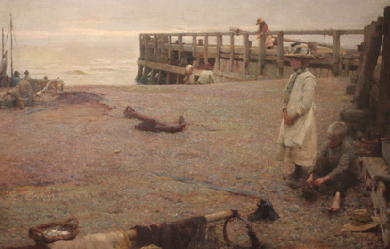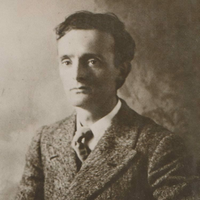
Info
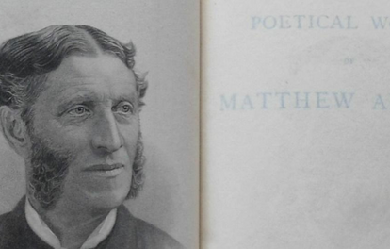
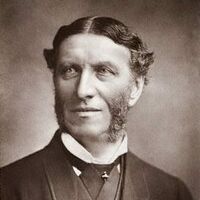
Although remembered now for his elegantly argued critical essays, Matthew Arnold (1822-1888) began his career as a poet, winning early recognition as a student at the Rugby School where his father, Thomas Arnold, had earned national acclaim as a strict and innovative headmaster. Arnold also studied at Balliol College, Oxford University. In 1844, after completing his undergraduate degree at Oxford, he returned to Rugby as a teacher of classics. After marrying in 1851, Arnold began work as a government school inspector, a grueling position which nonetheless afforded him the opportunity to travel throughout England and the Continent. Throughout his thirty-five years in this position Arnold developed an interest in education, an interest which fed into both his critical works and his poetry. Empedocles on Etna (1852) and Poems (1853) established Arnold's reputation as a poet and in 1857 he was offered a position, which he accepted and held until 1867, as Professor of Poetry at Oxford. Arnold became the first professor to lecture in English rather than Latin. During this time Arnold wrote the bulk of his most famous critical works, Essays in Criticism (1865) and Culture and Anarchy (1869), in which he sets forth ideas that greatly reflect the predominant values of the Victorian era. Meditative and rhetorical, Arnold's poetry often wrestles with problems of psychological isolation. In "To Marguerite—Continued," for example, Arnold revises Donne's assertion that "No man is an island," suggesting that we "mortals" are indeed "in the sea of life enisled." Other well-known poems, such as "Dover Beach," link the problem of isolation with what Arnold saw as the dwindling faith of his time. Despite his own religious doubts, a source of great anxiety for him, in several essays Arnold sought to establish the essential truth of Christianity. His most influential essays, however, were those on literary topics. In "The Function of Criticism" (1865) and "The Study of Poetry" (1880) Arnold called for a new epic poetry: a poetry that would address the moral needs of his readers, "to animate and ennoble them." Arnold's arguments, for a renewed religious faith and an adoption of classical aesthetics and morals, are particularly representative of mainstream Victorian intellectual concerns. His approach—his gentlemanly and subtle style—to these issues, however, established criticism as an art form, and has influenced almost every major English critic since, including T. S. Eliot, Lionel Trilling, and Harold Bloom. Though perhaps less obvious, the tremendous influence of his poetry, which addresses the poet's most innermost feelings with complete transparency, can easily be seen in writers as different from each other as W. B. Yeats, James Wright, Sylvia Plath, and Sharon Olds. Late in life, in 1883 and 1886, Arnold made two lecturing tours of the United States. Matthew Arnold died in Liverpool in 1888. A Selected Bibliography Poetry A Matthew Arnold Birthday Book (1883) Alaric at Rome: A Prize Poem (1840) Cromwell: A Prize Poem (1843) Empedocles on Etna and Other Poems (1852) Empedocles on Etna: A Dramatic Poem (1900) Merope: A Tragedy (1858) New Poems (1867) Poems: A New Edition (1853) Poems: Second Series (1855) The Poems of Matthew Arnold (1965) The Poetical Works of Matthew Arnold (1950) The Strayed Reveller and Other Poems (1849) The Works of Matthew Arnold (1903) Prose Essays, Letters, and Reviews by Matthew Arnold Essays, Letters, and Reviews by Matthew Arnold (1960) Friendship's Garland (1883) "Charles Augustin Sainte-Beuve," in Encyclopedia Britannica, ninth edition, IX: 162-165 (1886) "Isaiah of Jerusalem" in the Authorized English Version, with an Introduction, Corrections and Notes (1883) "Schools," in The Reign of Queen Victoria (1887) A Bible-Reading for Schools: The Great Prophecy of Israel's Restoration (1872) A French Eton; or, Middle Class Education and the State (1864) Arnold as Dramatic Critic (1903) Civilization in the United States: First and Last Impressions of America (1888) Complete Prose Works (1960) Culture and Anarchy (1883) Culture and Anarchy: An Essay in Political and Social Criticism (1869) Culture and the State (1965) Discourses in America (1885) Education Department (1886) England and the Italian Question (1859) England and the Italian Question, (1953) Essays in Criticism (1865) Essays in Criticism: Second Series (1888) Essays in Criticism: Third Series (1910) Five Uncollected Essays of Matthew Arnold (1953) General Grant, with a Rejoinder by Mark Twain (1966) General Grant: An Estimate (1887) God and the Bible: A Review of Objections to "Literature and Dogma" (1875) Heinrich Heine (1863) Higher Schools and Universities in Germany (1874) Irish Essays, and Others (1882) Isaiah XLLXVI; with the Shorter Prophecies Allied to It (1875) Last Essays on Church and Religion (1877) Letters of Matthew Arnold, 1848-1888 (1895) Letters of an Old Playgoer (1919) Letters, Speeches and Tracts on Irish Affairs by Edmund Burke (1881) Literature and Dogma: An Essay towards a Better Apprehension of the Bible (1873) Matthew Arnold's Letters: A Descriptive Checklist (1968) Matthew Arnold's Notebooks (1902) Mixed Essays (1879) On Home Rule for Ireland: Two Letters to "The Times" (1891) On Translating Homer: Last Words: A Lecture Given at Oxford (1862) On Translating Homer: Three Lectures Given at Oxford (1861) On the Modern Element in Literature (1869) On the Study of Celtic Literature (1883) Poems of Wordsworth (1879) Poetry of Byron (1881) Reports on Elementary Schools 1852-1882 (1889) Schools and Universities on the Continent (1867) St. Paul and Protestantism; with an Introduction on Puritanism and the Church of England (1883) The Hundred Greatest Men: Portraits of the One Hundred Greatest Men of History (1879) The Letters of Matthew Arnold to Arthur Hugh Clough (1932) The Note-Books of Matthew Arnold (1952) The Popular Education of France, with Notices of That of Holland and Switzerland (1861) The Six Chief Lives from Johnson's "Lives of the Poets," with Macaulay's "Life of Johnson," (1878) The Study of Poetry (1880) Thoughts on Education Chosen From the Writings of Matthew Arnold (1912) Unpublished Letters of Matthew Arnold (1923) References Poets.org - www.poets.org/poet.php/prmPID/88
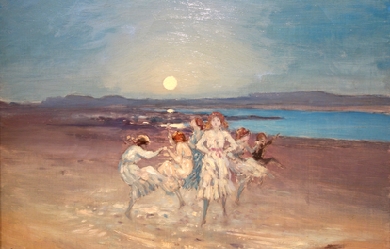
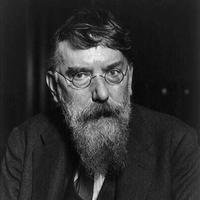
George William Russell (10 April 1867– 17 July 1935) who wrote with the pseudonym Æ (sometimes written AE or A.E.), was an Irish writer, editor, critic, poet, artistic painter and Irish nationalist. He was also a writer on mysticism, and a central personage in the group of devotees of theosophy which met in Dublin for many years.
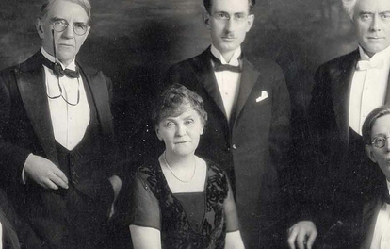
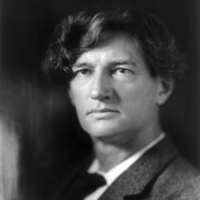
Bliss Carman FRSC (April 15, 1861– June 8, 1929) was a Canadian poet who lived most of his life in the United States, where he achieved international fame. He was acclaimed as Canada’s poet laureate during his later years. In Canada, Carman is classed as one of the Confederation Poets, a group which also included Charles G.D. Roberts (his cousin), Archibald Lampman, and Duncan Campbell Scott. “Of the group, Carman had the surest lyric touch and achieved the widest international recognition. But unlike others, he never attempted to secure his income by novel writing, popular journalism, or non-literary employment. He remained a poet, supplementing his art with critical commentaries on literary ideas, philosophy, and aesthetics.” Life He was born William Bliss Carman in Fredericton, in the Maritime province of New Brunswick. “Bliss” was his mother’s maiden name. He was the great grandson of United Empire Loyalists who fled to Nova Scotia after the American Revolution, settling in New Brunswick (then part of Nova Scotia). His literary roots run deep with an ancestry that includes a mother who was a descendant of Daniel Bliss of Concord, Massachusetts, the great-grandfather of Ralph Waldo Emerson. His sister married the botanist and historian William Francis Ganong. And on his mother’s side he was a first cousin to Charles (later Sir Charles) G. D. Roberts. Education and early career Carman was educated at the Fredericton Collegiate School and the University of New Brunswick (UNB), from which he received a B.A. in 1881. At the Collegiate School he came under the influence of headmaster George Robert Parkin, who gave him a love of classical literature and introduced him to the poetry of Dante Gabriel Rossetti and Algernon Charles Swinburne. His first published poem was in the UNB Monthly in 1879. He then spent a year at Oxford and the University of Edinburgh (1882–1883), but returned home to receive his M.A. from UNB in 1884. After the death of his father in January 1885 and his mother in February 1886, Carman enrolled in Harvard University (1886–1887). At Harvard he moved in a literary circle that included American poet Richard Hovey, who would become his close friend and his collaborator on the successful Vagabondia poetry series. Their circle included Herbert Copeland and F. Holland Day, who would later form the Boston publishing firm Copeland & Day that would launch Vagabondia. After Harvard Carman briefly returned to Canada, but was back in Boston by February 1890. “Boston is one of the few places where my critical education and tastes could be of any use to me in earning money,” he wrote. “New York and London are about the only other places.” Unable to find employment in Boston, he moved to New York City and became literary editor of the New York Independent at the grand sum of $20/week. There he could help his Canadian friends get published, in the process “introducing Canadian poets to its readers.” However, Carman was never a good fit at the semi-religious weekly, and he was summarily dismissed in 1892. "Brief stints would follow with Current Literature, Cosmopolitan, The Chap-Book, and The Atlantic Monthly, but after 1895 he would be strictly a contributor to the magazines and newspapers, never an editor in any department.” To make matters worse, Carman’s first book of poetry, 1893's Low Tide on Grand Pré, was not a success; no Canadian company would publish it, and the U.S. edition stiffed when its publisher went bankrupt. Literary success At this low point, Songs of Vagabondia, the first Hovey-Carman collaboration, was published by Copeland & Day in 1894. It was an immediate success. “No one could have been more surprised at the tremendous popularity of these care-free celebrations (the first of the three collections went through seven rapid editions) than the young authors, Richard Hovey and Bliss Carman.” Songs of Vagabondia would ultimately "go through sixteen printings (ranging from 500 to 1000 copies) over the next thirty years. The three Vagabondia volumes that followed fell slightly short of that record, but each went through numerous printings. Carman and Hovey quickly found themselves with a cult following, especially among college students, who responded to the poetry’s anti-materialistic themes, its celebration of individual freedom, and its glorification of comradeship.” The success of Songs of Vagabondia prompted another Boston firm, Stone & Kimball, to reissue Low Tide... and to hire Carman as the editor of its literary journal, The Chapbook. The next year, though, the editor’s job went West (with Stone & Kimball) to Chicago, while Carman opted to remain in Boston. “In Boston in 1895, he worked on a new poetry book, Behind the Arras, which he placed with a prominent Boston publisher (Lamson, Wolffe).... He published two more books of verse with Lamson, Wolffe." He also began writing a weekly column for the Boston Evening Transcript, which ran from 1895 to 1900. In 1896 Carman met Mary Perry King, who became the greatest and longest-lasting female influence in his life. Mrs. King became his patron: “She put pence in his purse, and food in his mouth, when he struck bottom and, what is more, she often put a song on his lips when he despaired, and helped him sell it.” According to Carman’s roommate, Mitchell Kennerley, "On rare occasions they had intimate relations at 10 E. 16 which they always advised me of by leaving a bunch of violets—Mary Perry’s favorite flower—on the pillow of my bed." If he knew of the latter, Dr. King did not object: "He even supported her involvement in the career of Bliss Carman to the extent that the situation developed into something close to a ménage à trois" with the Kings. Through Mrs. King’s influence Carman became an advocate of ‘unitrinianism,’ a philosophy which "drew on the theories of François-Alexandre-Nicolas-Chéri Delsarte to develop a strategy of mind-body-spirit harmonization aimed at undoing the physical, psychological, and spiritual damage caused by urban modernity." This shared belief created a bond between Mrs. King and Carman but estranged him somewhat from his former friends. In 1899 Lamson, Wolffe was taken over by the Boston firm of Small, Maynard & Co., who had also acquired the rights to Low Tide... "The rights to all Carman’s books were now held by one publisher and, in lieu of earnings, Carman took a financial stake in the company. When Small, Maynard failed in 1903, Carman lost all his assets.” Down but not out, Carman signed with another Boston company, L.C. Page, and began to churn out new work. Page published seven books of new Carman poetry between 1902 and 1905. As well, the firm released three books based on Carman’s Transcript columns, and a prose work on unitrinianism, The Making of Personality, that he’d written with Mrs. King. "Page also helped Carman rescue his ‘dream project,’ a deluxe edition of his collected poetry to 1903.... Page acquired distribution rights with the stipulation that the book be sold privately, by subscription. The project failed; Carman was deeply disappointed and became disenchanted with Page, whose grip on Carman’s copyrights would prevent the publication of another collected edition during Carman’s lifetime.” Carman also picked up some needed cash in 1904 as editor-in-chief of the 10-volume project, The World’s Best Poetry. Later years After 1908 Carman lived near the Kings’ New Canaan, Connecticut, estate, “Sunshine”, or in the summer in a cabin near their summer home in the Catskills, “Moonshine.” Between 1908 and 1920, literary taste began to shift, and his fortunes and health declined. “Although not a political activist, Carman during the First World War was a member of the Vigilantes, who supported American entry into the conflict on the Allied side.” By 1920, Carman was impoverished and recovering from a near-fatal attack of tuberculosis. That year he revisited Canada and “began the first of a series of successful and relatively lucrative reading tours, discovering ‘there is nothing worth talking of in book sales compared with reading.’” “'Breathless attention, crowded halls, and a strange, profound enthusiasm such as I never guessed could be,' he reported to a friend. ‘And good thrifty money too. Think of it! An entirely new life for me, and I am the most surprised person in Canada.’” Carman was feted at "a dinner held by the newly-formed Canadian Authors’ Association at the Ritz Carlton Hotel in Montreal on 28 October 1921 where he was crowned Canada’s Poet Laureate with a wreath of maple leaves.” The tours of Canada continued, and by 1925 Carman had finally acquired a Canadian publisher. "McClelland & Stewart (Toronto) issued a collection of selected earlier verses and became his main publisher. They benefited from Carman’s popularity and his revered position in Canadian literature, but no one could convince L.C. Page to relinquish its copyrights. An edition of collected poetry was published only after Carman’s death, due greatly to the persistence of his literary executor, Lorne Pierce.” During the 1920s, Carman was a member of the Halifax literary and social set, The Song Fishermen. In 1927 he edited The Oxford Book of American Verse. Carman died of a brain hemorrhage at the age of 68 in New Canaan, and was cremated in New Canaan. “It took two months, and the influence of New Brunswick’s Premier J.B.M. Baxter and Canadian Prime Minister W.L.M. King, for Carman’s ashes to be returned to Fredericton.” “His ashes were buried in Forest Hill Cemetery, Fredericton, and a national memorial service was held at the Anglican cathedral there.” Twenty-five years later, on May 13, 1954, a scarlet maple tree was planted at his gravesite, to grant his request in his 1892 poem “The Grave-Tree”: Let me have a scarlet maple For the grave-tree at my head, With the quiet sun behind it, In the years when I am dead. Writing Low Tide on Grand Pré As a student at Harvard, Carman “was heavily influenced by Royce, whose spiritualistic idealism, combined with the transcendentalism of Ralph Waldo Emerson, lies centrally in the background of his first major poem, ”Low Tide on Grand Pré" written in the summer and winter of 1886." “Low Tide...” was published in the Spring, 1887 Atlantic Monthly, giving Carman a literary reputation while still at Harvard. It was also included in the 1889 anthology, Songs of the Great Dominion. Literary critic Desmond Pacey considered “Low Tide...” to be “the most nearly perfect single poem to come out of Canada. It will withstand any amount of critical scrutiny.” “Low Tide...” served as the title poem for Carman’s first book. “The poems in this volume have been collected with reference to their similarity of tone,” Carman wrote in his preface; a nostalgic tone of pervading loss and melancholy. Three outstanding examples are “The Eavesdropper,” “In Apple Time” and “Wayfaring.” However, “none can equal the artistry of the title poem. What is more, although Carman would publish over thirty other volumes during his lifetime, none of them contains anything that surpasses this poem he wrote when he was barely twenty-five years old.” Vagabondia Carman rose to prominence in the 1890s, a decade the poetry of which anthologist Louis Untermeyer has called marked by “a cheerless evasion, a humorous unconcern; its most representative craftsmen were, with four exceptions, the writers of light verse.” The first two of those four exceptions were Richard Hovey and Bliss Carman. For Untermeyer: "The poetry of this period... is dead because it detached itself from the world.... But... revolt openly declared itself with the publication of Songs from Vagabondia (1894), More Songs from Vagabondia (1896), and Last Songs from Vagabondia (1900).... It was the heartiness, the gypsy jollity, the rush of high spirits, that conquered. Readers of the Vagabondia books were swept along by their speed faster than by their philosophy.” Even modernists loved Vagabondia. In the "October, 1912 issue of the London Poetry Review, Ezra Pound noted that he had ‘greatly enjoyed The Songs of Vagabondia by Mr. Bliss Carman and the late Richard Hovey.’” Carman’s most famous poem from the first volume is arguably “The Joys of the Open Road.” More Songs... contains “A Vagabond Song,” once familiar to a generation of Canadians. "Canadian youngsters who were in grade seven anytime between the mid-1930s and the 1950s were probably exposed to... 'A Vagabond Song’ [which] appeared in The Canada Book of Prose and Verse, Book One, the school reader that was used in nearly every province" (and was edited by Lorne Pierce). In 1912 Carman would publish Echoes from Vagabondia as a solo work. (Hovey had died in 1900). More of a remembrance book than part of the set, it has a distinct elegiac tone. It contains the lyric “The Flute of Spring”. Behind the Arras With Behind the Arras (1895), Carman continued his practice of “bringing together poems that were ‘in the same key.’ Whereas Low Tide on Grand Pré is elegiacal and melancholy, Songs from Vagabondia is mostly light and jaunty, while Behind the Arras is philosophical and heavy.” “Behind the Arras” the poem is a long meditation that uses the speaker’s house and its many rooms as a symbol of life and its choices. The poem does not succeed: “there are so many asides that the allegory is lost along with any point the poet hoped to make.” Ballad of Lost Haven In keeping with the “same key” idea, Carman’s Ballad of Lost Haven (1897) was a collection of poetry about the sea. Its notable poems include the macabre sea shanty, The Gravedigger. By the Aurelian Wall “By the Aurelian Wall” is Carman’s elegy to John Keats. It served as the title poem of his 1898 collection, a book of formal elegies. In the last poem in the book, “The Grave-Tree,” Carman writes about his own death. The Pipes of Pan “Pan, the goat-god, traditionally associated with poetry and with the fusion of the earthly and the divine, becomes Carman’s organizing symbol in the five volumes issued between 1902 and 1905" under the above title. Under the influence of Mrs. King, Carman had begun to write in both prose and poetry about the ideas of ‘unitrinianism,’ "a strategy of mind-body-spirit harmonization aimed at undoing the physical, psychological, and spiritual damage caused by urban modernity... therapeutic ideas [which] resulted in the five volumes of verse assembled in Pipes of Pan." The Dictionary of Canadian Biography (DCB) calls the series “a collection that contains many superb lyrics but, overall, evinces the dangers of a soporific aesthetic.” The 'superb lyrics’ include the much-anthologized “The Dead Faun” from Volume I, From the Book of Myths; “From the Green Book of the Bards”, the title poem of Volume II; “Lord of My Heart’s Elation” from the same volume; and many of the erotic poems of Volume III, Songs of the Sea Children (such as LIX “I loved you when the tide of prayer”). As a whole, though, the Pan series shows (perhaps more than any other work) the truth of Northrop Frye’s 1954 observation that Carman “badly needs a skillful and sympathetic selection.” Sappho: One Hundred Lyrics There were no such problems with Carman’s next book. Perhaps because of the underlying concept, Sappho: One Hundred Lyrics (1904) has a structure and unity that helps make it what has been called Carman’s “finest volume of poetry.” Sappho was an Ancient Greek poet from the island of Lesbos, who was included in the Greek canon of nine lyric poets. Most of her poetry, which was well-known and greatly admired throughout antiquity, has been lost, but her reputation has endured, supported by the surviving fragments of some of her poems. Carman’s method, as Charles G.D. Roberts saw it in his Introduction to the book,"apparently, has been to imagine each lost lyric as discovered, and then to translate it; for the indefinable flavor of the translation is maintained throughout, though accompanied by the fluidity and freedom of purely original work." It was a daunting task, as Roberts admits: “It is as if a sculptor of to-day were to set himself, with reverence, and trained craftsmanship, and studious familiarity with the spirit, technique, and atmosphere of his subject, to restore some statues of Polyclitus or Praxiteles of which he had but a broken arm, a foot, a knee, a finger upon which to build.” Yet, on the whole, Carman succeeded. “Written more or less contemporaneously with the love poems in Songs of the Sea Children, the Sappho reconstructions continue the amorous theme from a feminine point of view. Nevertheless, the feelings ascribed to Sappho are pure Carman in their sensitive and elegiac melancholy.” Virtually all of the lyrics are of high quality; some often-quoted are XXIII ("I loved thee, Atthis, in the long ago,"), LIV ("How soon will all my lovely days be over"), LXXIV ("If death be good"), LXXXII ("Over the roofs the honey-coloured moon"). “Next to Low Tide on Grand Pré, Sappho: One Hundred Lyrics seems to be the collection that continues to find the most favour among Carman’s critics. D.M.R. Bentley, for example, calls it ‘undoubtedly one of the most attractive, engaging and satisfying works of any of the Confederation poets.’” Bentley argued that "the brief, crisp lyrics of the Sappho volume almost certainly contributed to the aesthetic and practice of Imagism. Later work In his review of 1954's Selected Poems of Bliss Carman, literary critic Northrop Frye compared Carman and the other Confederation Poets to the Group of Seven: “Like the later painters, these poets were lyrical in tone and romantic in attitude; like the painters, they sought for the most part uninhabited landscape.” But Frye added: “The lyrical response to landscape is by itself, however, a kind of emotional photography, and like other forms of photography is occasional and epigrammatic.... Hence the lyric poet, after he has run his gamut of impressions, must die young, develop a more intellectualized attitude, or start repeating himself. Carman’s meeting of this challenge was only partly successful.” It is true that Carman had begun to repeat himself after Sappho. "Much of Carman’s writing in poetry and prose during the decade preceding World War I is as repetitive as the title of Echoes from Vagabondia (1912) intimates" says the DCB. What had made his poetry so remarkable at the beginning– that every new book was completely new– was gone. However, Carman’s career was by no means over. He "published four other collections of new poetry during his lifetime and two more were ready for publication at the time of his death: The Rough Rider, and Other Poems (1908), A Painter’s Holiday, and Other Poems (1911), April Airs (1916), Far Horizons (1925), Sanctuary (1929), and Wild Garden (1929). James Cappon’s comment on Far Horizons applies almost equally to the other five volumes: ‘There is nothing new in its poetic quality which has the sweet sadness of age rehearsing old tunes with an art which is now very smooth though with less vivacity than it used to have.’” Not only did Carman continue to write, but he continued to write fine poems: poems such as “The Old Grey Wall” (April Airs), the Wilfred Campbell-ish “Rivers of Canada” (Far Horizons), “The Ghost-yard of the Goldenrod” and “The Ships of Saint John” (Later Poems, 1926), and “The Winter Scene” (Sanctuary: The “Sunshine House” sonnets). The best of these have the same nostalgic air of melancholy and loss with which Carman began in “Low Tide...,” but now even more poignant as the poet approached his own death. Recognition In 1906 Carman received honorary degrees from UNB and McGill University. He was elected a corresponding Fellow of the Royal Society of Canada in 1925. The Society awarded him its Lorne Pierce Gold Medal in 1928. He was awarded a medal from the American Academy of Arts and Letters in 1929. In 1945, Carman was recognized as a Person of National Historic Significance by the government of Canada. Carman is honored by a sculpture erected on the UNB campus in 1947, which portrays him with fellow poets Sir Charles G.D. Roberts and Francis Joseph Sherman. There is a middle school named after him in Fredericton, New Brunswick (Bliss Carman Middle School). There is also a school named after him in Toronto, Ontario. “Bliss Carman Heights” (an extension of the Skyline Acres subdivision) is a subdivision located in Fredericton, New Brunswick overlooking the Saint John River. It consists of Essex Street, Gloucester Crescent, Reading Street, Ascot Court, and Ascot Drive. An extension of the Bliss Carman Heights subdivision is named “Poet’s Hill” and consists of Bliss Carman Drive, Poets Lane and Windflower Court (named for one of Carman’s poems of the same name). In October 1916, American composer Leo Sowerby was inspired to write his best-known organ piece, “Comes Autumn Time,” after reading Carman’s poem, “Autumn,” in the Literature section of the Sunday Edition of the Chicago Tribune on October 16 of that year. Publications Poetry collections * Low Tide on Grand Pre: A Book Of Lyrics. New York: Charles L. Webster. 1893. - Low Tide on Grand Pré: A Book of Lyrics at Google Books * Carman, Bliss; Hovey, Richard (1894). Songs From Vagabondia. Tom B. Meteyard, Illus. Boston: Copeland & Day. – Songs from Vagabondia at Google Books– A Vagabondia Songs (2013 Reprint) at Google Books * A Seamark: A Threnody for Robert Louis Stevenson. Boston: Copeland & Day. 1895. - A Seamark: A Threnody for Robert Louis Stevenson at Google Books * Behind The Arras: A Book Of The Unseen. Tom B. Meteyard, Illus. Boston: Lamson, Wolffe. 1895. * Ballads of Lost Haven: A Book Of The Sea. Boston: Lamson, Wolffe. 1897. * By The Aurelian Wall: And Other Elegies. Boston: Lamson, Wolffe. 1898. * Carman, Bliss; Hovey, Richard (1896). More Songs From Vagabondia. Tom B. Meteyard, Illus. Boston: Copeland & Day. – More Songs from Vagabondia at Google Books– A Vagabondia Songs (2013 Reprint) at Google Books * A Winter Holiday. Boston: Small, Maynard. 1899. * Carman, Bliss; Hovey, Richard (1901). Last Songs From Vagabondia. Tom B. Meteyard, Illus. Boston: Small, Maynard. – Last Songs from Vagabondia at Google Books– A Vagabondia Songs (2013 Reprint) at Google Books * Ballads and Lyrics. London: A.H. Bullen. 1902. * Ode on the Coronation of King Edward. Boston: L.C. Page. 1902. * Pipes Of Pan: From the Book of Myths. Boston: L.C. Page. 1902. - Pipes Of Pan: From the Book of Myths at Google Books * Pipes Of Pan: From the Green Book of the Bards. Boston: L.C. Page. 1903. - Pipes Of Pan: From the Green Book of the Bards at Google Books * Pipes Of Pan: Songs of the Sea Children. Boston: L.C. Page. 1904. - Pipes Of Pan: Songs of the Sea Children at Google Books * Pipes Of Pan: Songs From a Northern Garden. Boston: L.C. Page. 1904. - Pipes Of Pan: Songs From a Northern Garden at Google Books * Pipes Of Pan: From the Book of Valentines. Boston: L.C. Page. 1905. - Pipes Of Pan: From the Book of Valentines at Google Books * Sappho: One Hundred Lyrics. Intro. by Charles G.D. Roberts. Boston: L.C. Page. 1904. * Poems. (London: Chiswick P, 1905). * The Rough Rider: And Other Poems. New York: M. Kennerley. 1909. * A Painter’s Holiday, and Other Poems. New York: F.F. Sherman. 1911. * Echoes From Vagabondia. Boston: Small, Maynard. 1912. * April Airs: A Book Of New England Lyrics. Boston: Small, Maynard. 1916. * Carman, Bliss; King, Mary Perry (1918). The Man of The Marne: And Other Poems. New Canaan, Connecticut: Ponus Press. * The Vengeance of Noel Brassard: A Tale of the Acadian Expulsion (PDF). Cambridge, Massachusetts: The University Press. 1919. * Far Horizons. Boston: Small, Maynard and Company. 1925. - Far Horizons at Google Books * Later Poems. Toronto: McClelland & Steward. 1926. * Sanctuary: Sunshine House Sonnets. Whitman Bailey, Illus. Toronto: McClelland & Steward. 1929. * Wild Garden. Toronto: McClelland & Steward. 1929. * Bliss Carman’s Poems. New York: Dodd, Mead. 1931. - Bliss Carman’s Poems at Google Books * Pierce, Lorne, ed. (1954). The Selected Poems Of Bliss Carman. Toronto: McClelland & Stewart. * A Vision Of Sappho. Toronto: Canadiana House. 1968. * The Poems of Bliss Carman. Toronto: McClelland & Stewart. 1976. ISBN 978-0-7710-9509-2. * Souster, Raymond; Lochhead, Douglas, eds. (1985). Windflower: Poems Of Bliss Carman. Ottawa: Tecumseh. ISBN 978-0-919662-07-0. Drama * Bliss Carman and Mary Perry King. Daughters of Dawn: A Lyrical Pageant of Series of Historical Scenes for Presentation With Music and Dancing. (New York: M. Kennerley, 1913). * Bliss Carman and Mary Perry King. Earth Deities: And Other Rhythmic Masques. (New York: M. Kennerley, 1914). Prose collections * The Kinship Of Nature. Boston: L. C. Page. 1904. * The Poetry Of Life. Boston: L. C. Page. 1905. - The poetry of life (1906 ed.) at Google Books * The Friendship of Art. Boston: L. C. Page. 1908. - The Friendship of Art (Scholar’s Choice ed.). ISBN 978-1-2981-9930-0. * The Making of Personality. Boston: L. C. Page. 1908. - The Making of Personality at Google Books * Talks on Poetry and Life; Being a Series of Five Lectures Delivered Before the University of Toronto, December 1925 (Speech). transcribed by Blanche Hume. 1926. * Pierce, Lorne, ed. (1931). Bliss Carman’s Scrap-Book: A Table Of Contents. Toronto: Ryerson. * Gundy, H. Pearson, ed. (1982). Letters of Bliss Carman. Kingston, Ontario: McGill-Queen’s University Press. Edited * The World’s Best Poetry (10 volumes). New York: The University Society. 1904. - The World’s best poetry, Volume 1 at Google Books * The Oxford Book of American Verse (U.S. ed.). New York: Albert & Charles Boni. 1927. * Carman, Bliss; Pierce, Lorne, eds. (1935). Our Canadian Literature: Representative Verse, English and French. Toronto: Ryerson. Archive * Bliss Carman Papers, 1889–1927 (2 linear ft.) are housed in the Department of Special Collections and University Archives at Stanford University Libraries Sources * "Bliss Carman’s Letters To Margaret Lawrence, 1927-1929". Post-Confederation Poetry: Texts And Contexts. Ed. D.M.R. Bentley. London: Canadian Poetry P, 1995. * Bliss Carman: A Reappraisal. Ed. Gerald Lynch. Ottawa: University Of Ottawa Press, 1990. * Letters of Bliss Carman. Ed. H. Pearson Gundy. Kingston: McGill-Queen’s University P, 1981. * Hugh McPherson. The Literary Reputation Of Bliss Carman: A Study In The Development Of Canadian Taste In Poetry. 1950. * Muriel Miller. Bliss Carman, A Portrait. Toronto: Ryerson, 1935. * Muriel Miller. Bliss Carman: Quest And Revolt. St. John’s, Nfld.: Jesperson P, 1985. * Donald G Stephens. Bliss Carman. 1966. * Donald G. Stephens. The Influence Of English Poets Upon The Poetry Of Bliss Carman. 1955. * Margaret A. Stewart. Bliss Carman: Poet, Philosopher, Teacher. 1976. Further reading * Robert Gibbs, “Voice and Persona in Carman and Roberts,” in Atlantic Provinces Literature Colloquium Papers [ed. by Kenneth MacKinnon] (1977) * Nelson-McDermott, C. (Fall–Winter 1990). “Passionate Beauty: Carman’s Sappho Poems”. Canadian Poetry: Studies/Documents/Reviews (Canadian Poetry Press) 27: 40–45. * Malcolm Ross, “A Strange Aesthetic Ferment,” Canadian Literature, 68-69 (Spring-Summer 1976) * John Robert Sorfleet, "Transcendentalist, Mystic, Evolutionary Idealist: Bliss Carman 1886-1894," in Colony and Confederation [ed. George Woodcock](1974) * Thomas B. Vincent, “Bliss Carman: A Life in Literary Publishing,” Historical Perspectives on Canadian Publishing, McMaster.ca. Web. * Symons, Arthur (Fall–Winter 1995). Ware, Tracy, ed. “Arthur Symons’ Reviews of Bliss Carman”. Canadian Poetry: Studies/Documents/Reviews (Canadian Poetry Press) 37: 100–113. * Terry Whalen, Canadian Writers and Their Work: Volume Two [ed. Robert Lecker, Ellen Quigley, & Jack David] (1983) References Wikipedia—https://en.wikipedia.org/wiki/Bliss_Carman
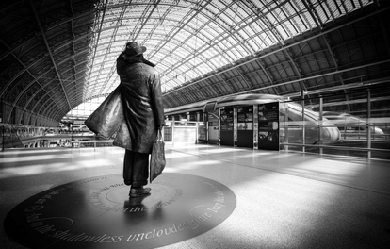
Sir John Betjeman, CBE (28 August 1906 – 19 May 1984) was an English poet, writer, and broadcaster who described himself in Who’s Who as a “poet and hack”. He was Poet Laureate of the United Kingdom from 1972 until his death. He was a founding member of the Victorian Society and a passionate defender of Victorian architecture. He began his career as a journalist and ended it as one of the most popular British Poets Laureate and a much-loved figure on British television.
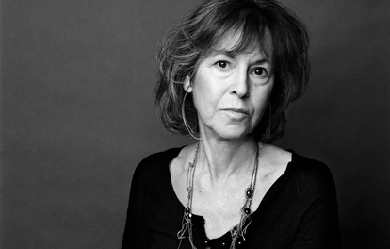
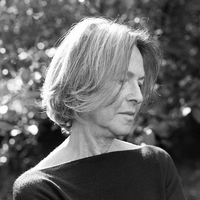
Louise Elisabeth Glück (born April 22, 1943) is an American poet. She was appointed Poet Laureate Consultant in Poetry to the Library of Congress in 2003. Louise was born in New York City of Hungarian Jewish heritage and grew up on Long Island. Her father, Daniel, an immigrant from Hungary, helped invent and market the X-Acto Knife. She graduated in 1961 from George W. Hewlett High School and went on to attend Sarah Lawrence College and later Columbia University; however, she did not graduate from either of them. Glück won the Pulitzer Prize for Poetry in 1993 for her collection The Wild Iris.
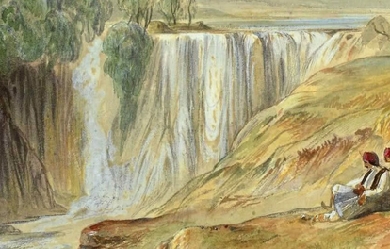
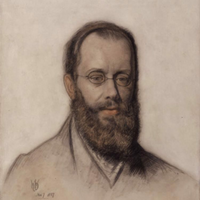
Edward Lear (12 or 13 May 1812 – 29 January 1888) was an English artist, illustrator, author and poet, and is known now mostly for his literary nonsense in poetry and prose and especially his limericks, a form he popularised. His principal areas of work as an artist were threefold: as a draughtsman employed to illustrate birds and animals; making coloured drawings during his journeys, which he reworked later, sometimes as plates for his travel books; as a (minor) illustrator of Alfred Tennyson's poems. As an author, he is known principally for his popular nonsense works, which use real and invented English words. Early years Lear was born into a middle-class family in the village of Holloway near London, the penultimate of twenty-one children (and youngest to survive) of Ann Clark Skerrett and Jeremiah Lear. He was raised by his eldest sister, also named Ann, 21 years his senior. Owing to the family's limited finances, Lear and his sister were required to leave the family home and live together when he was aged four. Ann doted on Edward and continued to act as a mother for him until her death, when he was almost 50 years of age. Lear suffered from lifelong health afflictions. From the age of six he suffered frequent grand mal epileptic seizures, and bronchitis, asthma, and during later life, partial blindness. Lear experienced his first seizure at a fair near Highgate with his father. The event scared and embarrassed him. Lear felt lifelong guilt and shame for his epileptic condition. His adult diaries indicate that he always sensed the onset of a seizure in time to remove himself from public view. When Lear was about seven years old he began to show signs of depression, possibly due to the instability of his childhood. He suffered from periods of severe melancholia which he referred to as "the Morbids.” Artist Lear was already drawing "for bread and cheese" by the time he was aged 16 and soon developed into a serious "ornithological draughtsman" employed by the Zoological Society and then from 1832 to 1836 by the Earl of Derby, who kept a private menagerie at his estate Knowsley Hall. Lear's first publication, published when he was 19 years old, was Illustrations of the Family of Psittacidae, or Parrots in 1830. His paintings were well received and he was compared favourably with the naturalist John James Audubon. Among other travels, he visited Greece and Egypt during 1848–49, and toured India and Ceylon (Sri Lanka) during 1873–75. While travelling he produced large quantities of coloured wash drawings in a distinctive style, which he converted later in his studio into oil and watercolour paintings, as well as prints for his books. His landscape style often shows views with strong sunlight, with intense contrasts of colour. Throughout his life he continued to paint seriously. He had a lifelong ambition to illustrate Tennyson's poems; near the end of his life a volume with a small number of illustrations was published. Relationships Lear's most fervent and painful friendship involved Franklin Lushington. He met the young barrister in Malta in 1849 and then toured southern Greece with him. Lear developed an undoubtedly homosexual passion for him that Lushington did not reciprocate. Although they remained friends for almost forty years, until Lear's death, the disparity of their feelings for one another constantly tormented Lear. Indeed, none of Lear's attempts at male companionship were successful; the very intensity of Lear's affections seemingly doomed the relationships. The closest he came to marriage with a woman was two proposals, both to the same person 46 years his junior, which were not accepted. For companions he relied instead on friends and correspondents, and especially, during later life, on his Albanian Souliote chef, Giorgis, a faithful friend and, as Lear complained, a thoroughly unsatisfactory chef. Another trusted companion in Sanremo was his cat, Foss, which died in 1886 and was buried with some ceremony in a garden at Villa Tennyson. San Remo and death Lear travelled widely throughout his life and eventually settled in Sanremo, on his beloved Mediterranean coast, in the 1870s, at a villa he named "Villa Tennyson". Lear was known to introduce himself with a long pseudonym: "Mr Abebika kratoponoko Prizzikalo Kattefello Ablegorabalus Ableborinto phashyph" or "Chakonoton the Cozovex Dossi Fossi Sini Tomentilla Coronilla Polentilla Battledore & Shuttlecock Derry down Derry Dumps" which he based on Aldiborontiphoskyphorniostikos. After a long decline in his health, Lear died at his villa in 1888, of the heart disease from which he had suffered since at least 1870. Lear's funeral was said to be a sad, lonely affair by the wife of Dr. Hassall, Lear's physician, none of Lear's many lifelong friends being able to attend. Lear is buried in the Cemetery Foce in San Remo. On his headstone are inscribed these lines about Mount Tomohrit (in Albania) from Tennyson's poem To E.L. [Edward Lear], On His Travels in Greece: all things fair. With such a pencil, such a pen. You shadow forth to distant men, I read and felt that I was there. The centenary of his death was marked in Britain with a set of Royal Mail stamps in 1988 and an exhibition at the Royal Academy. Lear's birthplace area is now marked with a plaque at Bowman's Mews, Islington, in London, and his bicentenary during 2012 was celebrated with a variety of events, exhibitions and lectures in venues across the world including an International Owl and Pussycat Day on his birthday. References Wikipedia – http://en.wikipedia.org/wiki/Edward_Lear
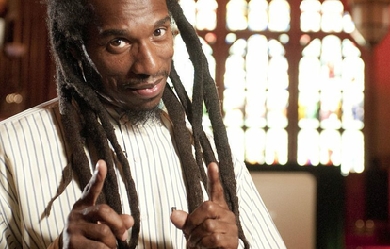

Benjamin Obadiah Iqbal Zephaniah (born 15 April 1958, Birmingham, England) is an English writer and dub poet. He is a well-known figure in contemporary English literature, and was included in The Times list of Britain's top 50 post-war writers in 2008. Zephaniah was born and raised in the Handsworth district of Birmingham, which he called the “Jamaican capital of Europe”. He is the son of a Barbadian postman and a Jamaican nurse. A dyslexic, he attended an approved school but left aged 13 unable to read or write. He writes that his poetry is strongly influenced by the music and poetry of Jamaica and what he calls “street politics”.
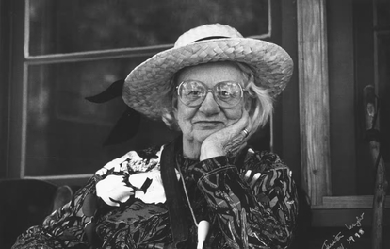
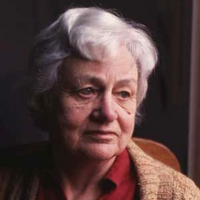
Judith Arundell Wright (31 May 1915 – 25 June 2000) was an Australian poet, environmentalist and campaigner for Aboriginal land rights. She was born in Armidale, New South Wales. The eldest child of Phillip Wright and his first wife, Ethel, she spent most of her formative years in Brisbane and Sydney. Wright was of Cornish ancestry. After the early death of her mother, she lived with her aunt and then boarded at New England Girls’ School after her father’s remarriage in 1929. After graduating, Wright studied Philosophy, English, Psychology and History at the University of Sydney. At the beginning of World War II, she returned to her father’s station to help during the shortage of labour caused by the war.
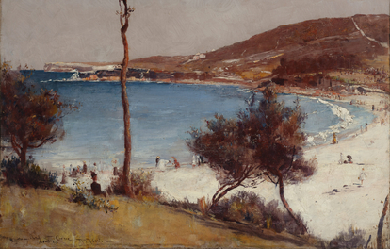
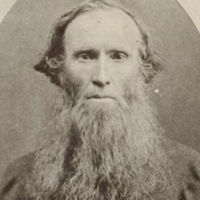
Charles Harpur (23 January 1813– 10 June 1868) was an Australian poet. He was born on 23 January 1813 at Windsor, New South Wales, the third child of Joseph Harpur—originally from Kinsale, County Cork, Ireland, parish clerk and master of the Windsor district school—and Sarah, née Chidley (from Somerset; both had been transported.) Harpur received his elementary education in Windsor. This was probably largely supplemented by private study; he was an eager reader of William Shakespeare. Harpur followed various avocations in the bush and for some years in his twenties held a clerical position at the post office in Sydney.
Donald Hall (September 20, 1928 – June 23, 2018) was an American poet born in New Haven, Connecticut, in 1928. He began writing as an adolescent and attended the Bread Loaf Writers' Conference at the age of sixteen—the same year he had his first work published. He earned a B.A. from Harvard in 1951 and a B. Litt. from Oxford in 1953.
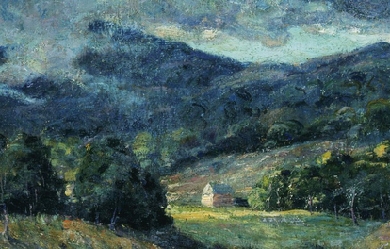
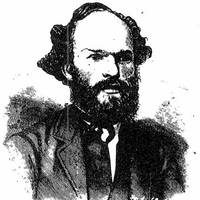
James McIntyre (baptised 25 May 1828– 31 March 1906), called The Cheese Poet, was a Canadian poet. McIntyre was born in Forres, Scotland and came to Canada in 1841 at the age of 14. He worked as a hired hand to begin with, performing pioneer chores that formed the basis of a number of his works. Later, he settled in St. Catharines, Ontario, where he dealt in furniture. There he married and had a daughter and son. He later moved to Ingersoll, Ontario, then a town of 5,000 on the banks of the Thames in Oxford County, the heart of Canadian dairy country at the time. He opened a furniture factory on the river as well as a store which sold furniture, along with such items as pianos and coffins. He was well loved in the community, from which he often received aid in hard times, due in part to his poesy and oratorical skills—he was called on to speak at every kind of social gathering in Ingersoll. The region seems to have inspired him, and it was in celebration of the proud history of Canada, the natural beauty and industry of the region, and especially (as noted above) its cheese, that the majority of his oeuvre was written. The ancient poets ne’er did dream That Canada was land of cream, They ne’er imagined it could flow In this cold land of ice and snow, Where everything did solid freeze They ne’er hoped or looked for cheese. from “Oxford Cheese Ode” [1] McIntyre was uninhibited by minor shortcomings—such as his lack of literary skills. The Toronto Globe ran his pieces as comic relief, and the New York Tribune expressed amusement, but their mockery did not dampen his enthusiasm. He is assumed to have continued writing until his death, in 1906. He published two volumes of poetry: Musings on the Canadian Thames (1884); Poems of James McIntyre (1889). McIntyre was forgotten after his death for a number of years, until his work was rediscovered and reprinted by William Arthur Deacon—literary editor of the Toronto Mail and Empire and its successor the Globe and Mail—in his book The Four Jameses (1927). In recent years a volume of his work, Oh! Queen of Cheese: Selections from James McIntyre, the Cheese Poet (ed. Roy A Abramson; Toronto: Cherry Tree, 1979) collected his poems together with a variety of cheese recipes and anecdotes. However, the greatest boost to his fame probably came from a number of his poems being anthologized in the collection Very Bad Poetry, edited by Ross and Kathryn Petras (Vintage, 1997). This included his masterpiece and possibly best-known poem, "Ode on the Mammoth Cheese Weighing Over 7,000 Pounds," written about an actual cheese produced in Ingersoll in 1866 and sent to exhibitions in Toronto, New York, and Britain: We have seen thee, Queen of Cheese, Lying quietly at your ease, Gently fanned by evening breeze; Thy fair form no flies dare seize. All gaily dressed, soon you’ll go To the provincial show, To be admired by many a beau In the city of Toronto. from “Ode on the Mammoth Cheese” [2] An annual poetry contest is held in Ingersoll, Ontario, to honour McIntyre. The contest is sponsored by The Ingersoll Times and the Corporation of the Town of Ingersoll, and includes a cheese-themed poetry competition. References Wikipedia—https://en.wikipedia.org/wiki/James_McIntyre_(poet)
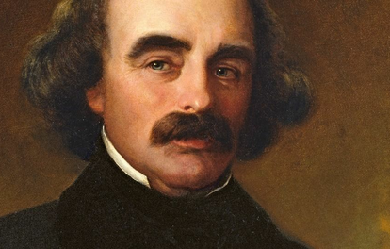
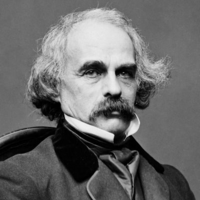
Nathaniel Hawthorne (July 4, 1804 – May 19, 1864) was an American novelist, dark romantic, and short story writer. He was born in 1804 in Salem, Massachusetts to Nathaniel Hathorne and the former Elizabeth Clarke Manning. His ancestors include John Hathorne, the only judge involved in the Salem witch trials who never repented of his actions. He entered Bowdoin College in 1821, was elected to Phi Beta Kappa in 1824, and graduated in 1825. He published his first work in 1828, the novel Fanshawe; he later tried to suppress it, feeling that it was not equal to the standard of his later work. He published several short stories in periodicals, which he collected in 1837 as Twice-Told Tales. The next year, he became engaged to Sophia Peabody. He worked at the Boston Custom House and joined Brook Farm, a transcendentalist community, before marrying Peabody in 1842. The couple moved to The Old Manse in Concord, Massachusetts, later moving to Salem, the Berkshires, then to The Wayside in Concord. The Scarlet Letter was published in 1850, followed by a succession of other novels. A political appointment as consul took Hawthorne and family to Europe before their return to Concord in 1860. Hawthorne died on May 19, 1864, and was survived by his wife and their three children. Much of Hawthorne’s writing centers on New England, many works featuring moral metaphors with an anti-Puritan inspiration. His fiction works are considered part of the Romantic movement and, more specifically, dark romanticism. His themes often center on the inherent evil and sin of humanity, and his works often have moral messages and deep psychological complexity. His published works include novels, short stories, and a biography of his college friend Franklin Pierce, the 14th President of the United States. Biography Early life Nathaniel Hawthorne was born on July 4, 1804, in Salem, Massachusetts; his birthplace is preserved and open to the public. William Hathorne was the author’s great-great-great-grandfather. He was a Puritan and was the first of the family to emigrate from England, settling in Dorchester, Massachusetts before moving to Salem. There he became an important member of the Massachusetts Bay Colony and held many political positions, including magistrate and judge, becoming infamous for his harsh sentencing. William’s son and the author’s great-great-grandfather John Hathorne was one of the judges who oversaw the Salem witch trials. Hawthorne probably added the “w” to his surname in his early twenties, shortly after graduating from college, in an effort to dissociate himself from his notorious forebears. Hawthorne’s father Nathaniel Hathorne, Sr. was a sea captain who died in 1808 of yellow fever in Suriname; he had been a member of the East India Marine Society. After his death, his widow moved with young Nathaniel and two daughters to live with relatives named the Mannings in Salem, where they lived for 10 years. Young Hawthorne was hit on the leg while playing “bat and ball” on November 10, 1813, and he became lame and bedridden for a year, though several physicians could find nothing wrong with him. In the summer of 1816, the family lived as boarders with farmers before moving to a home recently built specifically for them by Hawthorne’s uncles Richard and Robert Manning in Raymond, Maine, near Sebago Lake. Years later, Hawthorne looked back at his time in Maine fondly: “Those were delightful days, for that part of the country was wild then, with only scattered clearings, and nine tenths of it primeval woods.” In 1819, he was sent back to Salem for school and soon complained of homesickness and being too far from his mother and sisters. He distributed seven issues of The Spectator to his family in August and September 1820 for the sake of having fun. The homemade newspaper was written by hand and included essays, poems, and news featuring the young author’s adolescent humor. Hawthorne’s uncle Robert Manning insisted that the boy attend college, despite Hawthorne’s protests. With the financial support of his uncle, Hawthorne was sent to Bowdoin College in 1821, partly because of family connections in the area, and also because of its relatively inexpensive tuition rate. Hawthorne met future president Franklin Pierce on the way to Bowdoin, at the stage stop in Portland, and the two became fast friends. Once at the school, he also met future poet Henry Wadsworth Longfellow, future congressman Jonathan Cilley, and future naval reformer Horatio Bridge. He graduated with the class of 1825, and later described his college experience to Richard Henry Stoddard: I was educated (as the phrase is) at Bowdoin College. I was an idle student, negligent of college rules and the Procrustean details of academic life, rather choosing to nurse my own fancies than to dig into Greek roots and be numbered among the learned Thebans. Early career In 1836, Hawthorne served as the editor of the American Magazine of Useful and Entertaining Knowledge. At the time, he boarded with poet Thomas Green Fessenden on Hancock Street in Beacon Hill in Boston. He was offered an appointment as weigher and gauger at the Boston Custom House at a salary of $1,500 a year, which he accepted on January 17, 1839. During his time there, he rented a room from George Stillman Hillard, business partner of Charles Sumner. Hawthorne wrote in the comparative obscurity of what he called his “owl’s nest” in the family home. As he looked back on this period of his life, he wrote: “I have not lived, but only dreamed about living.” He contributed short stories to various magazines and annuals, including “Young Goodman Brown” and “The Minister’s Black Veil”, though none drew major attention to him. Horatio Bridge offered to cover the risk of collecting these stories in the spring of 1837 into the volume Twice-Told Tales, which made Hawthorne known locally. Marriage and family While at Bowdoin, Hawthorne wagered a bottle of Madeira wine with his friend Jonathan Cilley that Cilley would get married before Hawthorne did. By 1836, he had won the bet, but he did not remain a bachelor for life. He had public flirtations with Mary Silsbee and Elizabeth Peabody, then he began pursuing Peabody’s sister, illustrator and transcendentalist Sophia Peabody. He joined the transcendentalist Utopian community at Brook Farm in 1841, not because he agreed with the experiment but because it helped him save money to marry Sophia. He paid a $1,000 deposit and was put in charge of shoveling the hill of manure referred to as “the Gold Mine”. He left later that year, though his Brook Farm adventure became an inspiration for his novel The Blithedale Romance. Hawthorne married Sophia Peabody on July 9, 1842 at a ceremony in the Peabody parlor on West Street in Boston. The couple moved to The Old Manse in Concord, Massachusetts, where they lived for three years. His neighbor Ralph Waldo Emerson invited him into his social circle, but Hawthorne was almost pathologically shy and stayed silent at gatherings. At the Old Manse, Hawthorne wrote most of the tales collected in Mosses from an Old Manse. Like Hawthorne, Sophia was a reclusive person. Throughout her early life, she had frequent migraines and underwent several experimental medical treatments. She was mostly bedridden until her sister introduced her to Hawthorne, after which her headaches seem to have abated. The Hawthornes enjoyed a long and happy marriage. He referred to her as his “Dove” and wrote that she “is, in the strictest sense, my sole companion; and I need no other—there is no vacancy in my mind, any more than in my heart... Thank God that I suffice for her boundless heart!” Sophia greatly admired her husband’s work. She wrote in one of her journals: I am always so dazzled and bewildered with the richness, the depth, the... jewels of beauty in his productions that I am always looking forward to a second reading where I can ponder and muse and fully take in the miraculous wealth of thoughts. Poet Ellery Channing came to the Old Manse for help on the first anniversary of the Hawthornes’ marriage. A local teenager named Martha Hunt had drowned herself in the river and Hawthorne’s boat Pond Lily was needed to find her body. Hawthorne helped recover the corpse, which he described as “a spectacle of such perfect horror... She was the very image of death-agony”. The incident later inspired a scene in his novel The Blithedale Romance. The Hawthornes had three children. Their first was daughter Una, born March 3, 1844; her name was a reference to The Faerie Queene, to the displeasure of family members. Hawthorne wrote to a friend, “I find it a very sober and serious kind of happiness that springs from the birth of a child... There is no escaping it any longer. I have business on earth now, and must look about me for the means of doing it.” In October 1845, the Hawthornes moved to Salem. In 1846, their son Julian was born. Hawthorne wrote to his sister Louisa on June 22, 1846: “A small troglodyte made his appearance here at ten minutes to six o’clock this morning, who claimed to be your nephew.” Daughter Rose was born in May 1851, and Hawthorne called her his “autumnal flower”. Middle years In April 1846, Hawthorne was officially appointed as the “Surveyor for the District of Salem and Beverly and Inspector of the Revenue for the Port of Salem” at an annual salary of $1,200. He had difficulty writing during this period, as he admitted to Longfellow: I am trying to resume my pen... Whenever I sit alone, or walk alone, I find myself dreaming about stories, as of old; but these forenoons in the Custom House undo all that the afternoons and evenings have done. I should be happier if I could write. This employment, like his earlier appointment to the custom house in Boston, was vulnerable to the politics of the spoils system. Hawthorne was a Democrat and lost this job due to the change of administration in Washington after the presidential election of 1848. He wrote a letter of protest to the Boston Daily Advertiser which was attacked by the Whigs and supported by the Democrats, making Hawthorne’s dismissal a much-talked about event in New England. He was deeply affected by the death of his mother in late July, calling it “the darkest hour I ever lived”. He was appointed the corresponding secretary of the Salem Lyceum in 1848. Guests who came to speak that season included Emerson, Thoreau, Louis Agassiz, and Theodore Parker. Hawthorne returned to writing and published The Scarlet Letter in mid-March 1850, including a preface that refers to his three-year tenure in the Custom House and makes several allusions to local politicians—who did not appreciate their treatment. It was one of the first mass-produced books in America, selling 2,500 volumes within ten days and earning Hawthorne $1,500 over 14 years. The book was pirated by booksellers in London and became a best-seller in the United States; it initiated his most lucrative period as a writer. Hawthorne’s friend Edwin Percy Whipple objected to the novel’s “morbid intensity” and its dense psychological details, writing that the book “is therefore apt to become, like Hawthorne, too painfully anatomical in his exhibition of them”, though 20th-century writer D. H. Lawrence said that there could be no more perfect work of the American imagination than The Scarlet Letter. Hawthorne and his family moved to a small red farmhouse near Lenox, Massachusetts at the end of March 1850. He became friends with Herman Melville beginning on August 5, 1850 when the authors met at a picnic hosted by a mutual friend. Melville had just read Hawthorne’s short story collection Mosses from an Old Manse, and his unsigned review of the collection was printed in The Literary World on August 17 and August 24 entitled “Hawthorne and His Mosses”. Melville was composing Moby-Dick at the time, and he wrote that these stories revealed a dark side to Hawthorne, “shrouded in blackness, ten times black”. Melville dedicated Moby-Dick (1851) to Hawthorne: “In token of my admiration for his genius, this book is inscribed to Nathaniel Hawthorne.” Hawthorne’s time in the Berkshires was very productive. While there, he wrote The House of the Seven Gables (1851), which poet and critic James Russell Lowell said was better than The Scarlet Letter and called “the most valuable contribution to New England history that has been made.” He also wrote The Blithedale Romance (1852), his only work written in the first person. He also published A Wonder-Book for Girls and Boys in 1851, a collection of short stories retelling myths which he had been thinking about writing since 1846. Nevertheless, poet Ellery Channing reported that Hawthorne “has suffered much living in this place”. The family enjoyed the scenery of the Berkshires, although Hawthorne did not enjoy the winters in their small house. They left on November 21, 1851. Hawthorne noted, “I am sick to death of Berkshire... I have felt languid and dispirited, during almost my whole residence.” The Wayside and Europe In May 1852, the Hawthornes returned to Concord where they lived until July 1853. In February, they bought The Hillside, a home previously inhabited by Amos Bronson Alcott and his family, and renamed it The Wayside. Their neighbors in Concord included Emerson and Henry David Thoreau. That year, Hawthorne wrote The Life of Franklin Pierce, the campaign biography of his friend which depicted him as “a man of peaceful pursuits”. Horace Mann said, “If he makes out Pierce to be a great man or a brave man, it will be the greatest work of fiction he ever wrote.” In the biography, Hawthorne depicts Pierce as a statesman and soldier who had accomplished no great feats because of his need to make “little noise” and so “withdrew into the background”. He also left out Pierce’s drinking habits, despite rumors of his alcoholism, and emphasized Pierce’s belief that slavery could not “be remedied by human contrivances” but would, over time, “vanish like a dream”. With Pierce’s election as President, Hawthorne was rewarded in 1853 with the position of United States consul in Liverpool shortly after the publication of Tanglewood Tales. The role was considered the most lucrative foreign service position at the time, described by Hawthorne’s wife as “second in dignity to the Embassy in London”. His appointment ended in 1857 at the close of the Pierce administration, and the Hawthorne family toured France and Italy. During his time in Italy, the previously clean-shaven Hawthorne grew a bushy mustache. The family returned to The Wayside in 1860, and that year saw the publication of The Marble Faun, his first new book in seven years. Hawthorne admitted that he had aged considerably, referring to himself as “wrinkled with time and trouble”. Later years and death At the outset of the American Civil War, Hawthorne traveled with William D. Ticknor to Washington, D.C. where he met Abraham Lincoln and other notable figures. He wrote about his experiences in the essay “Chiefly About War Matters” in 1862. Failing health prevented him from completing several more romances. Hawthorne was suffering from pain in his stomach and insisted on a recuperative trip with his friend Franklin Pierce, though his neighbor Bronson Alcott was concerned that Hawthorne was too ill. While on a tour of the White Mountains, he died in his sleep on May 19, 1864 in Plymouth, New Hampshire. Pierce sent a telegram to Elizabeth Peabody asking her to inform Mrs. Hawthorne in person. Mrs. Hawthorne was too saddened by the news to handle the funeral arrangements herself. Hawthorne’s son Julian was a freshman at Harvard College, and he learned of his father’s death the next day; coincidentally, he was initiated into the Delta Kappa Epsilon fraternity on the same day by being blindfolded and placed in a coffin. Longfellow wrote a tribute poem to Hawthorne published in 1866 called “The Bells of Lynn”. Hawthorne was buried on what is now known as “Authors’ Ridge” in Sleepy Hollow Cemetery, Concord, Massachusetts. Pallbearers included Longfellow, Emerson, Alcott, Oliver Wendell Holmes Sr., James Thomas Fields, and Edwin Percy Whipple. Emerson wrote of the funeral: "I thought there was a tragic element in the event, that might be more fully rendered—in the painful solitude of the man, which, I suppose, could no longer be endured, & he died of it.” His wife Sophia and daughter Una were originally buried in England. However, in June 2006, they were reinterred in plots adjacent to Hawthorne. Writings Hawthorne had a particularly close relationship with his publishers William Ticknor and James Thomas Fields. Hawthorne once told Fields, “I care more for your good opinion than for that of a host of critics.” In fact, it was Fields who convinced Hawthorne to turn The Scarlet Letter into a novel rather than a short story. Ticknor handled many of Hawthorne’s personal matters, including the purchase of cigars, overseeing financial accounts, and even purchasing clothes. Ticknor died with Hawthorne at his side in Philadelphia in 1864; according to a friend, Hawthorne was left “apparently dazed”. Literary style and themes Hawthorne’s works belong to romanticism or, more specifically, dark romanticism, cautionary tales that suggest that guilt, sin, and evil are the most inherent natural qualities of humanity. Many of his works are inspired by Puritan New England, combining historical romance loaded with symbolism and deep psychological themes, bordering on surrealism. His depictions of the past are a version of historical fiction used only as a vehicle to express common themes of ancestral sin, guilt and retribution. His later writings also reflect his negative view of the Transcendentalism movement. Hawthorne was predominantly a short story writer in his early career. Upon publishing Twice-Told Tales, however, he noted, “I do not think much of them,” and he expected little response from the public. His four major romances were written between 1850 and 1860: The Scarlet Letter (1850), The House of the Seven Gables (1851), The Blithedale Romance (1852) and The Marble Faun (1860). Another novel-length romance, Fanshawe, was published anonymously in 1828. Hawthorne defined a romance as being radically different from a novel by not being concerned with the possible or probable course of ordinary experience. In the preface to The House of the Seven Gables, Hawthorne describes his romance-writing as using “atmospherical medium as to bring out or mellow the lights and deepen and enrich the shadows of the picture”. Critics have applied feminist perspectives and historicist approaches to Hawthorne’s depictions of women. Feminist scholars are interested particularly in Hester Prynne, who realized that she herself could not be the “destined prophetess,” but that “angel and apostle of the coming revelation” must be a woman." Camille Paglia saw Hester as mystical, “a wandering goddess still bearing the mark of her Asiatic origins... moving serenely in the magic circle of her sexual nature”. Lauren Berlant termed Hester "the citizen as woman [personifying] love as a quality of the body that contains the purest light of nature," her resulting “traitorous political theory” a “Female Symbolic” literalization of futile Puritan metaphors. Historicists view Hester as a protofeminist and avatar of the self-reliance and responsibility that led to women’s suffrage and reproductive emancipation. Anthony Splendora found her literary genealogy among other archetypally fallen but redeemed women, both historic and mythic. As examples, he offers Psyche of ancient legend; Heloise of twelfth-century France’s tragedy involving world-renowned philosopher Peter Abelard; Anne Hutchinson (America’s first heretic, circa 1636), and Hawthorne family friend Margaret Fuller. In Hester’s first appearance, Hawthorne likens her, “infant at her bosom”, to Mary, Mother of Jesus, “the image of Divine Maternity”. In her study of Victorian literature, in which such “galvanic outcasts” as Hester feature prominently, Nina Auerbach went so far as to name Hester’s fall and subsequent redemption, “the novel’s one unequivocally religious activity”. Regarding Hester as a deity figure, Meredith A. Powers found in Hester’s characterization “the earliest in American fiction that the archetypal Goddess appears quite graphically,” like a Goddess “not the wife of traditional marriage, permanently subject to a male overlord”; Powers noted “her syncretism, her flexibility, her inherent ability to alter and so avoid the defeat of secondary status in a goal-oriented civilization”. Aside from Hester Prynne, the model women of Hawthorne’s other novels—from Ellen Langton of Fanshawe to Zenobia and Priscilla of The Blithedale Romance, Hilda and Miriam of The Marble Faun and Phoebe and Hepzibah of The House of the Seven Gables—are more fully realized than his male characters, who merely orbit them. This observation is equally true of his short-stories, in which central females serve as allegorical figures: Rappaccini’s beautiful but life-altering, garden-bound, daughter; almost-perfect Georgiana of “The Birthmark”; the sinned-against (abandoned) Ester of “Ethan Brand”; and goodwife Faith Brown, linchpin of Young Goodman Brown’s very belief in God. “My Faith is gone!” Brown exclaims in despair upon seeing his wife at the Witches’ Sabbath.. Hawthorne also wrote nonfiction. In 2008, Library of America selected Hawthorne’s “A show of wax-figures” for inclusion in its two-century retrospective of American True Crime. Criticism Edgar Allan Poe wrote important, and somewhat unflattering, reviews of both Twice-Told Tales and Mosses from an Old Manse. Poe’s negative assessment was partly due to his own contempt of allegory and moral tales, and his chronic accusations of plagiarism, though he admitted, The style of Mr. Hawthorne is purity itself. His tone is singularly effective—wild, plaintive, thoughtful, and in full accordance with his themes... We look upon him as one of the few men of indisputable genius to whom our country has as yet given birth. Ralph Waldo Emerson wrote, “Nathaniel Hawthorne’s reputation as a writer is a very pleasing fact, because his writing is not good for anything, and this is a tribute to the man.” Henry James praised Hawthorne, saying, “The fine thing in Hawthorne is that he cared for the deeper psychology, and that, in his way, he tried to become familiar with it.” Poet John Greenleaf Whittier wrote that he admired the “weird and subtle beauty” in Hawthorne’s tales. Evert Augustus Duyckinck said of Hawthorne, “Of the American writers destined to live, he is the most original, the one least indebted to foreign models or literary precedents of any kind.” Contemporary response to Hawthorne’s work praised his sentimentality and moral purity while more modern evaluations focus on the dark psychological complexity. Beginning in the 1950s, critics have focused on symbolism and didacticism. The critic Harold Bloom has opined that only Henry James and William Faulkner challenge Hawthorne’s position as the greatest American novelist, although he admits that he favors James as the greatest American novelist. Bloom sees Hawthorne’s greatest works to be principally The Scarlet Letter, followed by The Marble Faun and certain short stories, including “My Kinsman, Major Molineux”, “Young Goodman Brown”, “Wakefield”, and “Feathertop”. Selected works * The “definitive edition” of Hawthorne’s works is The Centenary Edition of the Works of Nathaniel Hawthorne, edited by William Charvat and others, published by The Ohio State University Press in twenty-three volumes between 1962 and 1997. Tales and Sketches (1982) was the second volume to be published in the Library of America, Collected Novels (1983) the tenth. Novels * Fanshawe (published anonymously, 1828) * The New Adam and Eve (1843) * The Scarlet Letter (1850) * The House of the Seven Gables (1851) * The Blithedale Romance (1852) * The Marble Faun: Or, The Romance of Monte Beni (1860) (as Transformation: Or, The Romance of Monte Beni, UK publication, same year) * The Dolliver Romance (1863) (unfinished) * Septimius Felton; or, the Elixir of Life (unfinished, published in the Atlantic Monthly, 1872) * Doctor Grimshawe’s Secret: A Romance (unfinished, with preface and notes by Julian Hawthorne, 1882) Short story collections * Twice-Told Tales (1837) * Grandfather’s Chair (1840) * Mosses from an Old Manse (1846) * A Wonder-Book for Girls and Boys (1851) * The Snow-Image, and Other Twice-Told Tales (1852) * Tanglewood Tales (1853) * The Dolliver Romance and Other Pieces (1876) * The Great Stone Face and Other Tales of the White Mountains (1889) Selected short stories * “Roger Malvin’s Burial” (1832) * “My Kinsman, Major Molineux” (1832) * “The Minister’s Black Veil” (1832) * “Young Goodman Brown” (1835) * “The Gray Champion” (1835) * “The White Old Maid” (1835) * “Wakefield” (1835) * “The Ambitious Guest” (1835) * “The Man of Adamant” (1837) * “The May-Pole of Merry Mount” (1837) * “The Great Carbuncle” (1837) * “Dr. Heidegger’s Experiment” (1837) * “A Virtuoso’s Collection” (May 1842) * “The Birth-Mark” (March 1843) * “The Celestial Railroad” (1843) * “Egotism; or, The Bosom-Serpent” (1843) * “Rappaccini’s Daughter” (1844) * “P.'s Correspondence” (1845) * “The Artist of the Beautiful” (1846) * “Fire Worship” (1846) * “Ethan Brand” (1850) * “The Great Stone Face” (1850) * “Feathertop” (1852) Nonfiction * Twenty Days with Julian & Little Bunny (written 1851, published 1904) * Our Old Home (1863) * Passages from the French and Italian Notebooks (1871) References Wikipedia—https://en.wikipedia.org/wiki/Nathaniel_Hawthorne
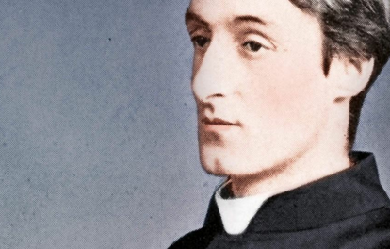
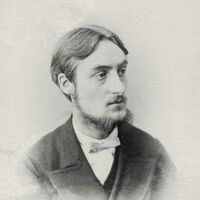
Gerard Manley Hopkins (28 July 1844 – 8 June 1889) was an English poet, Roman Catholic convert, and Jesuit priest, whose posthumous fame established him among the leading Victorian poets. His experimental explorations in prosody (especially sprung rhythm) and his use of imagery established him as a daring innovator in a period of largely traditional verse.
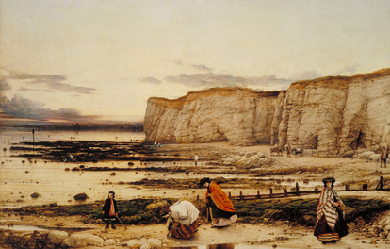
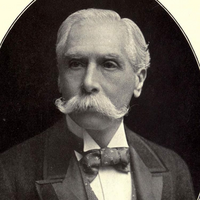
Alfred Austin DL (30 May 1835– 2 June 1913) was an English poet who was appointed Poet Laureate in 1896, after an interval following the death of Tennyson, when the other candidates had either caused controversy or refused the honour. It was claimed that he was being rewarded for his support for the Conservative leader Lord Salisbury in the General Election of 1895. Austin’s poems are little-remembered today, his most popular work being prose idylls celebrating nature.
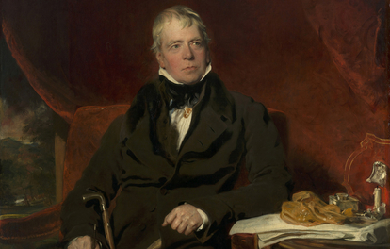
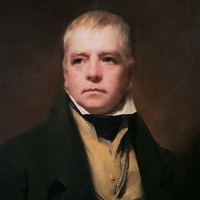
Sir Walter Scott, 1st Baronet, FRSE (15 August 1771– 21 September 1832) was a Scottish historical novelist, playwright and poet with many contemporary readers in Europe, Australia, and North America. Scott’s novels and poetry are still read, and many of his works remain classics of both English-language literature and of Scottish literature. Famous titles include Ivanhoe, Rob Roy, Old Mortality, The Lady of the Lake, Waverley, The Heart of Midlothian and The Bride of Lammermoor.
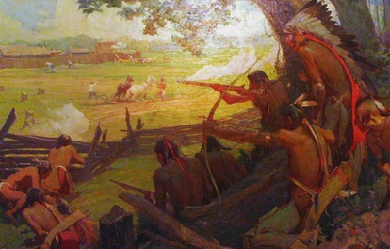
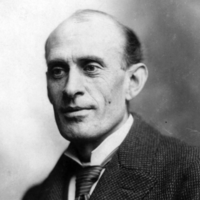
Eugene Field, Sr. (September 2, 1850 – November 4, 1895) was an American writer, best known for his children's poetry and humorous essays. Field was born in St. Louis, Missouri where today his boyhood home is open to the public as The Eugene Field House and St. Louis Toy Museum. After the death of his mother in 1856, he was raised by a cousin, Mary Field French, in Amherst, Massachusetts.
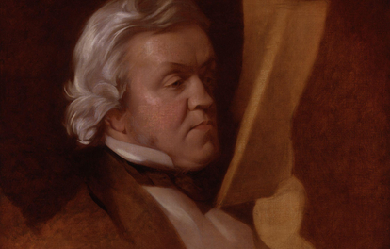
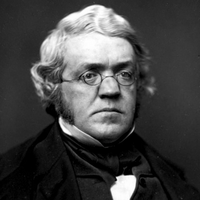
William Makepeace Thackeray (18 July 1811– 24 December 1863) was an English novelist of the 19th century. He is famous for his satirical works, particularly Vanity Fair, a panoramic portrait of English society. He began as a satirist and parodist, writing works that displayed a sneaking fondness for roguish upstarts such as Becky Sharp in Vanity Fair, and the title characters of The Luck of Barry Lyndon and Catherine. In his earliest works, written under such pseudonyms as Charles James Yellowplush, Michael Angelo Titmarsh and George Savage Fitz-Boodle, he tended towards savagery in his attacks on high society, military prowess, the institution of marriage and hypocrisy.

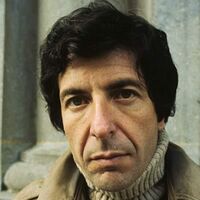
Leonard Norman Cohen (21 September 1934 – 10 November 2016) was a Canadian Juno Award-winning singer-songwriter, musician, poet, and novelist. His work often explores religion, isolation, sexuality, and personal relationships. Cohen has been inducted into the American Rock and Roll Hall of Fame and both the Canadian Music Hall of Fame and the Canadian Songwriters Hall of Fame. He is also a Companion of the Order of Canada, the nation's highest civilian honour. In 2011, Cohen received a Prince of Asturias Award for literature. Cohen's writing process, as he told an interviewer in 1998, is “like a bear stumbling into a beehive or a honey cache: I'm stumbling right into it and getting stuck, and it's delicious and it's horrible and I'm in it and it's not very graceful and it's very awkward and it's very painful and yet there's something inevitable about it”.
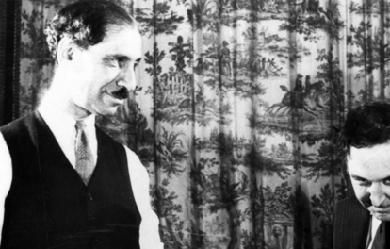
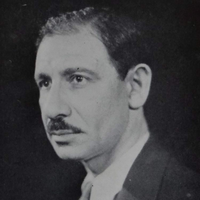
Franklin Pierce Adams (November 15, 1881– March 23, 1960) was an American columnist, well known by his initials F.P.A., and wit, best known for his newspaper column, “The Conning Tower”, and his appearances as a regular panelist on radio’s Information Please. A prolific writer of light verse, he was a member of the Algonquin Round Table of the 1920s and 1930s. New York newspaper columnist Adams was born Franklin Leopold Adams to Moses and Clara Schlossberg Adams in Chicago on November 15, 1881. He changed his middle name to “Pierce” when he had a Jewish confirmation ceremony at age 13. Adams graduated from the Armour Scientific Academy (now Illinois Institute of Technology) in 1899, attended the University of Michigan for one year and worked in insurance for three years. Signing on with the Chicago Journal in 1903, he wrote a sports column and then a humor column, “A Little about Everything”. The following year he moved to the New York Evening Mail, where he worked from 1904 to 1913 and began his column, then called “Always in Good Humor”, which used reader contributions. During his time on the Evening Mail, Adams wrote what remains his best known work, the poem Baseball’s Sad Lexicon, a tribute to the Chicago Cubs double play combination of “Tinker to Evers to Chance”. In 1911, he added a second column, a parody of Samuel Pepys’s Diary, with notes drawn from F.P.A.'s personal experiences. In 1914, he moved his column to the New-York Tribune, where it was famously retitled The Conning Tower and was considered to be “the pinnacle of verbal wit”. During World War I, Adams was in the U.S. Army, serving in military intelligence and also writing a column, “The Listening Post”, for Stars and Stripes editor Harold Ross. After the war, the so-called “comma-hunter of Park Row” (for his knowledge of the language) returned to New York and the Tribune. He moved to the New York World in 1922, and his column appeared there until the paper merged with the inferior New York Telegram in 1931. He returned to his old paper, by then called the New York Herald Tribune, until 1937, and finally moved to the New York Post, where he ended his column in September 1941. During its long run, “The Conning Tower” featured contributions from such writers as Robert Benchley, Edna Ferber, Moss Hart, George S. Kaufman, Edna St. Vincent Millay, John O’Hara, Dorothy Parker and Deems Taylor. Having one’s work published in “The Conning Tower” was enough to launch a career, as in the case of Dorothy Parker and James Thurber. Parker quipped, “He raised me from a couplet.” Parker dedicated her 1936 publication of collected poems, Not So Deep as a Well, to F.P.A. Many of the poems in that collection were originally published in “The Conning Tower”. Much later, the writer E. B. White freely admitted his sense of awe: "I used to walk quickly past the house in West 13th Street between Sixth and Seventh where F.P.A. lived, and the block seemed to tremble under my feet—the way Park Avenue trembles when a train leaves Grand Central.” Adams is credited with coining the term “aptronym” for last names that fit a person’s career or job title, although it was later refined to “aptonym” by Frank Nuessel in 1992. Satires No Sirree!, staged for one night only in April 1922, was a take-off of a then-popular European touring revue called La Chauve-Souris directed by Nikita Balieff. Robert Benchley is often credited as the first person to suggest the parody of Balieff’s group. No Sirree! had its genesis at the studio of Neysa McMein, which served as something of a salon for Round Tablers away from the Algonquin. Acts included: “Opening Chorus” featuring Woollcott, Toohey, Kaufman, Connelly, Adams, and Benchley with violinist Jascha Heifetz providing offstage, off-key accompaniment; “He Who Gets Flapped,” a musical number featuring the song “The Everlastin’ Ingenue Blues” written by Dorothy Parker and performed by Robert Sherwood accompanied by “chorus girls” including Tallulah Bankhead, Helen Hayes, Ruth Gillmore, Lenore Ulric, and Mary Brandon; “Zowie, or the Curse of an Akins Heart”; “The Greasy Hag, an O’Neill Play in One Act” with Kaufman, Connelly and Woollcott; and “Mr. Whim Passes By - An A. A. Milne Play.” F.P.A. often included parodies in his column. His satire of Edgar Allan Poe’s poem “Annabel Lee” was later collected in his book Something Else Again (1910): Soul Bride Oddly Dead in Queer Death Pact High-Born Kinsman Abducts Girl from Poet-Lover—Flu Said to Be Cause of Death—Grand Jury to Probe Annabel L. Poe of 1834½ 3rd Ave., the beautiful young fiancee of Edmund Allyn Poe, a magazine writer from the South, was found dead early this morning on the beach off E. 8th Street. Poe seemed prostrated and, questioned by the police, said that one of her aristocratic relatives had taken her to the “seashore,” but that the cold winds had given her “flu,” from which she never “rallied.” Detectives at work on the case believe, they say, that there was a suicide compact between the Poes and that Poe also intended to do away with himself. He refused to leave the spot where the woman’s body had been found. Radio As a panelist on radio’s Information Please (1938–48), he was the designated expert on poetry, old barroom songs and Gilbert and Sullivan, which he always referred to as Sullivan and Gilbert. A running joke on the show was that his stock answer for quotes that he didn’t know was that Shakespeare was the author. (Perhaps that was a running gag: Information Please’s creator/producer Dan Golenpaul auditioned Adams for the job with a series of sample questions, starting with: “Who was the Merchant of Venice?” Adams: “Antonio.” Golenpaul: “Most people would say ‘Shylock.’” Adams: “Not in my circle.”) John Kieran was the real Shakespearean expert and could quote from his works at length. A translator of Horace and other classical authors, F.P.A. also collaborated with O. Henry on Lo, a musical comedy. Film portrayal Adams was portrayed by the actor Chip Zien in the film Mrs. Parker and the Vicious Circle (1994). Bibliography Books * His books include In Cupid’s Court (1902), Tobogganning on Parnassus (1911), In Other Words (1912) and Answer This One (a 1927 trivia book with Harry Hansen). The two-volume The Diary of Our Own Samuel Pepys, collected from his newspaper columns, was published in 1935 by Simon and Schuster. The Melancholy Lute (1936) featured Adams’ selections from three decades of his work. Articles * F. P. A. (February 21, 1925). “Short-story scenarios”. The New Yorker. 1 (1): 19. * (October 9, 1926). “A day in the courts”. The New Yorker. 2 (41): 29. * (March 5, 1927). “Grant”. The Talk of the Town. The New Yorker. 3 (10): 20. * F. P. A.; Harold Ross; James Thurber (April 30, 1927). “Mot”. The Talk of the Town. The New Yorker. 3 (18): 19. * F. P. A.; E. B. White (April 7, 1927). “Another”. The Talk of the Town. The New Yorker. 3 (19): 19. Quotes * “I find that a great part of the information I have was acquired by looking up something and finding something else on the way.” * “To err is human; to forgive, infrequent.” * “Elections are won by men and women chiefly because most people vote against somebody rather than for somebody.” References Wikipedia—https://en.wikipedia.org/wiki/Franklin_Pierce_Adams
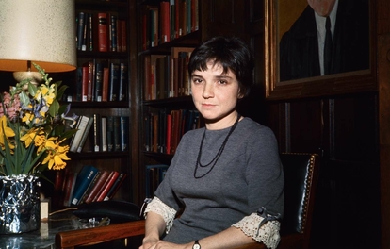
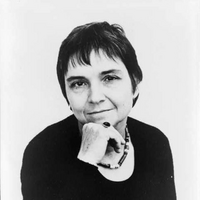
Adrienne Cecile Rich (May 16, 1929– March 27, 2012) was an American poet, essayist and radical feminist. She was called “one of the most widely read and influential poets of the second half of the 20th century”, and was credited with bringing “the oppression of women and lesbians to the forefront of poetic discourse.” Her first collection of poetry, A Change of World, was selected by renowned poet W. H. Auden for the Yale Series of Younger Poets Award. Auden went on to write the introduction to the published volume. She famously declined the National Medal of Arts, protesting the vote by House Speaker Newt Gingrich to end funding for the National Endowment for the Arts. Adrienne Rich was born in Baltimore, Maryland, the elder of two sisters. Her father, renowned pathologist Arnold Rice Rich, was the Chairman of Pathology at The Johns Hopkins Medical School. Her mother, Helen Elizabeth (Jones) Rich, was a concert pianist and a composer. Her father was from a Jewish family, and her mother was Southern Protestant; the girls were raised as Christians. Adrienne Rich’s early poetic influence stemmed from her father who encouraged her to read but also to write her own poetry. Her interest in literature was sparked within her father’s library where she read the work of writers such as Ibsen, Arnold, Blake, Keats, Rossetti, and Tennyson. Her father was ambitious for Adrienne and “planned to create a prodigy.” Adrienne Rich and her younger sister were home schooled by their mother until Adrienne began public education in the fourth grade. The poems Sources and After Dark document her relationship with her father, describing how she worked hard to fulfill her parents’ ambitions for her—moving into a world in which she was expected to excel.
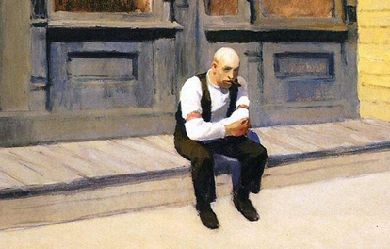
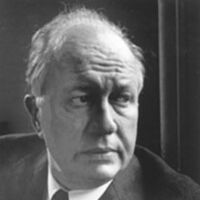
Theodore Roethke (ret-kee; May 25, 1908 – August 1, 1963) was an American poet, who published several volumes of poetry characterized by its rhythm, rhyming, and natural imagery. He was awarded the Pulitzer Prize for poetry in 1954 for his book, The Waking, and he won the annual National Book Award for Poetry twice, in 1959 for Words for the Wind and posthumously in 1965 for The Far Field. Roethke was born in Saginaw, Michigan and grew up on the west side of the Saginaw River. His father, Otto, was a German immigrant, a market-gardener who owned a large local 25 acre greenhouse, along with his brother (Theodore's uncle). Much of Theodore's childhood was spent in this greenhouse, as reflected by the use of natural images in his poetry. The poet's adolescent years were jarred, however, by his uncle's suicide and by the death of his father from cancer, both in early 1923, when Theodore (Ted) was only 15. These deaths shaped Roethke's psyche and creative life. He attended the University of Michigan, earning A.B. and M.A. degrees. He briefly attended law school before entering Harvard University, where he studied under the poet Robert Hillyer. Abandoning graduate study because of the Great Depression, he taught English at several universities, including Lafayette College, Pennsylvania State University, and Bennington College. In 1940, he was expelled from his position at Lafayette and he returned to Michigan. Just prior to his return, he had an affair with established poet and critic Louise Bogan, who later became one of his strongest early supporters. While teaching at Michigan State University in East Lansing, he began to suffer from manic depression, which fueled his poetic impetus. His last teaching position was at the University of Washington, leading to an association with the poets of the American Northwest. Some of his best known students included James Wright, Carolyn Kizer, Jack Gilbert, Richard Hugo, and David Wagoner. In 1953, Roethke married Beatrice O'Connell, a former student. Like many other American poets of his generation, Roethke was a heavy drinker and susceptible, as mentioned, to bouts of mental illness. He did not inform O'Connell of his repeated episodes of depression, yet she remained dedicated to him and his work. She ensured the posthumous publication of his final volume of poetry, The Far Field, which includes the poem "Meditation at Oyster River." In 1961, "The Return" was featured on George Abbe's album Anthology of Contemporary American Poetry on Folkways Records. The following year, Roethke released his own album on the label entitled, Words for the Wind: Poems of Theodore Roethke. He suffered a heart attack in his friend S. Rasnics' swimming pool in 1963 and died on Bainbridge Island, Washington, aged 55. The pool was later filled in and is now a zen rock garden, which can be viewed by the public at the Bloedel Reserve, a 150-acre (60 hectare) former private estate. There is no sign to indicate that the rock garden was the site of Roethke's death. There is a sign that commemorates his boyhood home and burial in Saginaw, Michigan. The historical marker notes in part: Theodore Roethke (1908–1963) wrote of his poetry: The greenhouse "is my symbol for the whole of life, a womb, a heaven-on-earth." Roethke drew inspiration from his childhood experiences of working in his family's Saginaw floral company. Beginning is 1941 with Open House, the distinguished poet and teacher published extensively, receiving a Pulitzer Prize for poetry and two National Book Awards among an array of honors. In 1959 Pennsylvania University awarded him the Bollingen Prize. Roethke taught at Michigan State College, (present-day Michigan State University) and at colleges in Pennsylvania and Vermont, before joining the faculty of the University of Washington at Seattle in 1947. Roethke died in Washington in 1963. His remains are interred in Saginaw's Oakwood Cemetery. The Friends of Theodore Roethke Foundation maintains his birthplace at 1805 Gratiot in Saginaw as a museum. In 1995, the Seattle alley between Seventh and Eighth Avenues N.E. running from N.E. 45th Street to N.E. 47th Street was named Roethke Mews in his honor. It adjoins the Blue Moon Tavern, one of Roethke's haunts. Critical responses The poet Stanley Kunitz said of Roethke, "The poet of my generation who meant most to me, in his person and in his art, was Theodore Roethke." The Poetry Foundation entry on Roethke notes early reviews of his work and Roethke's response to that early criticism: W. H. Auden called [Roethke's first book] Open House "completely successful." In another review of the book, Elizabeth Drew felt "his poems have a controlled grace of movement and his images the utmost precision; while in the expression of a kind of gnomic wisdom which is peculiar to him as he attains an austerity of contemplation and a pared, spare strictness of language very unusual in poets of today." Roethke kept both Auden's and Drew's reviews, along with other favorable reactions to his work. As he remained sensitive to how peers and others he respected should view his poetry, so too did he remain sensitive to his introspective drives as the source of his creativity. Understandably, critics picked up on the self as the predominant preoccupation in Roethke's poems. Roethke's breakthrough book, The Lost Son, also won him considerable praise. For instance, Michael Harrington felt "Roethke found his own voice and central themes in The Lost Son and Stanley Kunitz saw a "confirmation that he was in full possession of his art and of his vision." In Against Oblivion, an examination of forty-five twentieth century poets, the critic Ian Hamilton also praised this book, writing, "In Roethke's second book, The Lost Son, there are several of these greenhouse poems and they are among the best things he wrote; convincing and exact, and rich in loamy detail." In addition to the well-known greenhouse poems, the Poetry Foundation notes that Roethke also won praise "for his love poems which first appeared in The Waking and earned their own section in the new book [and] 'were a distinct departure from the painful excavations of the monologues and in some respects a return to the strict stanzaic forms of the earliest work,' [according to the poet] Stanley Kunitz. [The critic] Ralph Mills described 'the amatory verse' as a blend of 'consideration of self with qualities of eroticism and sensuality; but more important, the poems introduce and maintain a fascination with something beyond the self, that is, with the figure of the other, or the beloved woman.'" In reviewing his posthumously published Collected Poems in 1966, Karl Malkoff of The Sewanee Review wrote: Bibliography * Open House (1941) * The Lost Son and Other Poems (1948) * Praise to the End! (1951) * The Waking (1953) * Words For The Wind (1958) * I Am! Says The Lamb (1961) * Party at the Zoo" (1963) (A Modern Masters Book for Children, illustrated by Al Swiller) * The Far Field (1964) * Dirty Dinky and Other Creatures: Poems for Children (1973) * On Poetry and Craft: Selected Prose and Craft of Theodore Roethke (Copper Canyon Press, 2001) * Straw for the Fire: From the Notebooks of Theodore Roethke, 1943-63 (1972; Copper Canyon * Press, 2006) (selected and arranged by David Wagoner) References Wikipedia - http://en.wikipedia.org/wiki/Theodore_Roethke
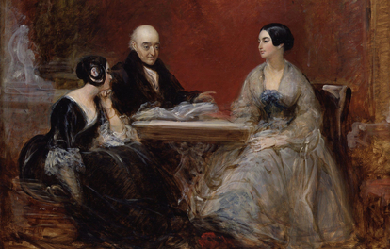
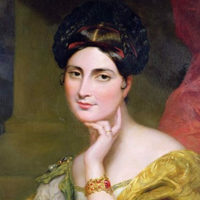
Caroline Elizabeth Sarah Norton (22 March 1808 – 15 June 1877) was an English social reformer, and author of the early and mid-nineteenth century. Caroline left her husband in 1836, following which her husband sued her close friend Lord Melbourne, the then Whig Prime Minister, for criminal conversation. The jury threw out the claim, but Caroline was unable to obtain a divorce and was denied access to her three sons. Caroline's intense campaigning led to the passing of the Custody of Infants Act 1839, the Matrimonial Causes Act 1857 and the Married Women's Property Act 1870. Caroline modelled for the fresco of Justice in the House of Lords by Daniel Maclise, who chose her because she was seen by many as a famous victim of injustice.
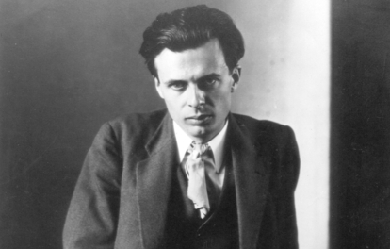
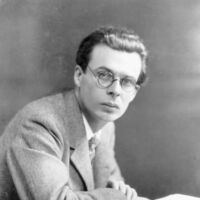
Aldous Leonard Huxley (26 July 1894 – 22 November 1963) was an English writer, philosopher and a prominent member of the Huxley family. He was best known for his novels including Brave New World, set in a dystopian London, and for non-fiction books, such as The Doors of Perception, which recalls experiences when taking a psychedelic drug, and a wide-ranging output of essays.
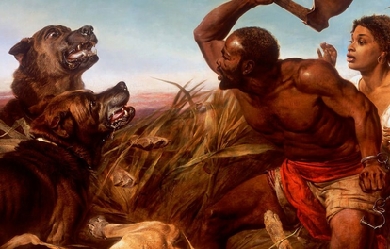
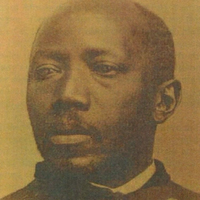
George Moses Horton (1798–1884) was an African-American poet and the first African American poet to be published in the Southern United States. His book was published in 1828 while he was still enslaved; he remained enslaved until he was emancipated late in the Civil War. Biography Horton was born into slavery on William Horton’s plantation in Northampton County, North Carolina. He was the sixth of ten children, though the names of his parents are lost to history. As a very young child in 1800, he and several family members were moved to a tobacco farm in rural Chatham County, when his owner relocated. He was given as property to William’s relative James Horton in 1814. In 1819, the estate was broken up, and George Moses Horton’s family was separated (the poem “Division of an Estate” reflected on the experience years later). Horton disliked farm work and in his free time he taught himself to read using spelling books, the Bible, and hymnals. Learning poetry and snippets of literature, Horton composed poems in his mind. As a young adult, Horton delivered produce to the University of North Carolina at Chapel Hill, where he composed and recited poems for students, some of whom transcribed his compositions. Horton also composed poems, usually love poems, by commission for the students at 25 or 50 cents each. Considering the difficulty of earning income from poetry, Horton was likely one of the few professional poets in the South at the time. In 1829, his poems were published in a collection titled The Hope of Liberty, which was intended to raise funds for his release from slavery. The book, funded by the politically-liberal journalist Joseph Gales, appeared the same year as David Walker’s An Appeal to the Coloured Citizens of the World. Horton is believed to be the first Southern black to publish poetry. Though he knew how to read, he published the book before he learned how to write. As he recalled, “I fell to work in my head, and composed several undigested pieces.” By 1832, he had learned to write for himself, having learned with the aid of Caroline Lee Hentz, who was the wife of a professor and a writer herself. She also assisted in publishing at least two of his poems in a newspaper. Horton had composed a poem on the death of Hentz’s child. As he recalled: “She was extremely pleased with the dirge which I wrote on the death of her much lamented primogenial infant, and for which she gave me much credit and a handsome reward. Not being able to write myself, I dictated while she wrote.” She sent one of Horton’s poems to her hometown newspaper in Lancaster, Massachusetts, where it was published on April 8, 1828, as “Liberty and Slavery”. Horton’s first book was republished under the title Poems by a Slave in 1837 and compiled with a biography and poetry by Phillis Wheatley a year later in a book called Memoir and Poems of Phillis Wheatley, a Native African and Slave: Also Poems by a Slave. The book was published by Boston-based publisher and abolitionist Isaac Knapp, and it is believed to be the first complete collection of Wheatley’s poems in book form. In 1845, Horton released another book of poetry, The Poetical Works of George M. Horton, The Colored Bard of North-Carolina, To Which Is Prefixed The Life of the Author, Written by Himself. The moniker, “Colored Bard of North-Carolina”, was coined by his new publisher. Horton gained the admiration of North Carolina Governor John Owen, influential newspapermen Horace Greeley and William Lloyd Garrison, along with numerous Northern abolitionists. Sometime in the 1830s, Horton married an enslaved woman owned by Franklin Snipes in Chatham County. The couple had two children, Free and Rhody, though little else is known about the family. Horton had written about his interest in the new nation of Liberia, and a few of the abolitionist papers made calls to raise enough money so that Horton could see his dream of life in Liberia come true. He was not emancipated until 1865, however, when he met the Ninth Cavalry from Michigan. A young officer with that group, William H. S. Banks, collaborated with Horton on the collection Naked Genius the same year. At the age of 68, Horton moved to Pennsylvania as a freeman where he continued to write poetry for local newspapers. One such publication, “Forbidden to Ride on the Street Cars”, shows his disappointment in the unjust treatment of blacks even after emancipation. In Philadelphia, he wrote Sunday school stories on behalf of friends who lived in the city. His exact death location and date are unknown. At least one researcher suggests Horton moved to Liberia at some point. Poetry After Horton’s first poem was published in the Lancaster, Massachusetts Gazette, his works appeared in other newspapers like the Register in Raleigh, North Carolina, and the Freedom’s Journal in New York City. Horton’s poetic style was typical of contemporary European poetry and was similar to poems written by free white contemporaries, likely a reflection of his reading and his work for commission. He wrote both sonnets and ballads, and his earlier works focused on his life in servitude. Such topics, however, were more generalized and not necessarily based on his personal experience. Nevertheless, he referred to his life on “vile accursed earth” and the “drudg’ry, pain, and toil” of life, as well as his oppression “because my skin is black”. His first collection was focused heavily on the issue of slavery and bondage. Likely because sales from that book were not enough for him to purchase his freedom, his second book mentions slavery only twice. The change in theme is also likely due to the more restrictive climate in the South in the years leading up to the Civil War. His later works, especially those made after his emancipation, were more rural and pastoral. Like other early black American writers like Jupiter Hammon and Phillis Wheatley, Horton was also heavily influenced by the Bible. The earliest known critical commentary on Horton’s writing is from 1909 by UNC professor Collier Cobb, who dismissed Horton’s antislavery themes: “George never really cared for more liberty than he had, but was fond of playing to the grandstand.”. Legacy Winston-Salem, North Carolina opened the George Moses Horton Branch Library in 1927 in a YWCA building. The George Moses Horton Society for the Study of African American Poetry was founded in 1996, the same year he was inducted into the North Carolina Literary Hall of Fame. The next year, 1997, he was named Historic Poet Laureate of Chatham County, North Carolina. In 2006, UNC Chapel Hill named a dormitory for George Moses Horton; it was formerly called Hinton James North and is believed to be the first university dormitory in the country to be named for a slave. In 2015 author/illustrator Don Tate published Poet: The Remarkable Story of George Moses Horton, an illustrated biography of Horton for children. The Wilson Library at UNC hosted the national launch of the book on September 3, 2015. Published works The Hope of Liberty (1829) Poems by a Slave (1837) The Poetical Works of George M. Horton (1845) Naked Genius (1865, with William H. S. Banks) References Wikipedia—https://en.wikipedia.org/wiki/George_Moses_Horton
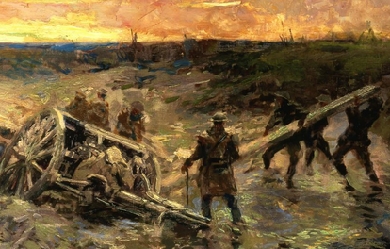
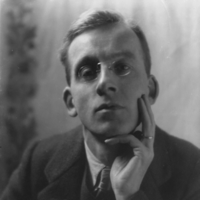
Wilfrid Wilson Gibson (2 October 1878– 26 May 1962) was a British Georgian poet, associated with World War I but also the author of much later work. Early work Gibson was born in Hexham, Northumberland, and left the north for London in 1914 after his mother died. He had been publishing poems in magazines since 1895, and his first collections in book form were published by Elkin Mathews in 1902. His collections of verse plays and dramatic poems The Stonefolds and On The Threshold were published by the Samurai Press (of Cranleigh) in 1907, followed next year by the book of poems, The Web of Life. Despite his residence in London, and later in Gloucestershire, many of Gibson’s poems both then and later, have Northumberland settings: Hexham’s Market Cross; Hareshaw; and The Kielder Stone. Others deal with poverty and passion amid wild Northumbrian landscapes. Still others are devoted to fishermen, industrial workers and miners, often alluding to local ballads and the rich folk-song heritage of the North East. It was in London that he met both Edward Marsh and Rupert Brooke, becoming a close friend and later Brooke’s literary executor (with Lascelles Abercrombie and Walter de la Mare). This was at the period when the first Georgian Poetry anthology was being hatched. Gibson was one of the insiders. During the early part of his writing life, Wilfrid Wilson Gibson wrote poems that featured the “macabre.” One such poem is Flannan Isle, based on a real life mystery. Gibson was one of the founders of the so-called ”Dymock poets”, a community of writers who settled briefly, before the outbreak of the Great War, in the village of Dymock, in north Gloucestershire. Reputation His reputation was eclipsed somewhat by the Ezra Pound-T. S. Eliot school of Modernist poetry; his work remained popular. Further reading Dominic Hibberd, Wilfrid Gibson and Harold Monro, the Pioneers (Cecil Woolf, 2006) References Wikipedia—https://en.wikipedia.org/wiki/Wilfrid_Wilson_Gibson
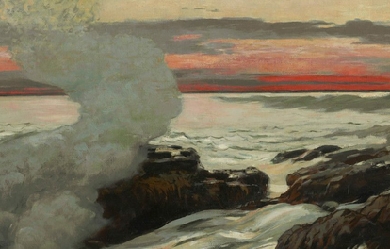
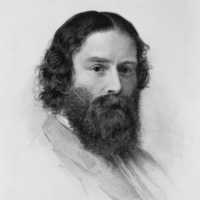
James Russell Lowell (/ˈloʊəl/; February 22, 1819– August 12, 1891) was an American Romantic poet, critic, editor, and diplomat. He is associated with the Fireside Poets, a group of New England writers who were among the first American poets who rivaled the popularity of British poets. These poets usually used conventional forms and meters in their poetry, making them suitable for families entertaining at their fireside. Lowell graduated from Harvard College in 1838, despite his reputation as a troublemaker, and went on to earn a law degree from Harvard Law School. He published his first collection of poetry in 1841 and married Maria White in 1844. He and his wife had several children, though only one survived past childhood. The couple soon became involved in the movement to abolish slavery, with Lowell using poetry to express his anti-slavery views and taking a job in Philadelphia, Pennsylvania, as the editor of an abolitionist newspaper. After moving back to Cambridge, Lowell was one of the founders of a journal called The Pioneer, which lasted only three issues. He gained notoriety in 1848 with the publication of A Fable for Critics, a book-length poem satirizing contemporary critics and poets. The same year, he published The Biglow Papers, which increased his fame. He went on to publish several other poetry collections and essay collections throughout his literary career. Maria White died in 1853, and Lowell accepted a professorship of languages at Harvard in 1854; he continued to teach there for twenty years. He traveled to Europe before officially assuming his role in 1856. He married his second wife, Frances Dunlap, shortly thereafter in 1857. That year Lowell also became editor of The Atlantic Monthly. It was not until 20 years later that Lowell received his first political appointment, the ambassadorship to the Kingdom of Spain. He was later appointed ambassador to the Court of St. James’s. He spent his last years in Cambridge, in the same estate where he was born, and died there in 1891. Lowell believed that the poet played an important role as a prophet and critic of society. He used poetry for reform, particularly in abolitionism. However, Lowell’s commitment to the anti-slavery cause wavered over the years, as did his opinion on African-Americans. Lowell attempted to emulate the true Yankee accent in the dialogue of his characters, particularly in The Biglow Papers. This depiction of the dialect, as well as Lowell’s many satires, was an inspiration to writers like Mark Twain and H.L. Mencken. Biography Early life The first of the Lowell family ancestors to come to the United States from Britain was Percival Lowle, who settled in Newbury, Massachusetts, in 1639. James Russell Lowell was born February 22, 1819, the son of the Reverend Charles Russell Lowell, Sr. (1782–1861), a minister at a Unitarian church in Boston, who had previously studied theology at Edinburgh, and Harriett Brackett Spence Lowell. By the time James Russell Lowell was born, the family owned a large estate in Cambridge called Elmwood. He was the youngest of six children; his siblings were Charles, Rebecca, Mary, William, and Robert. Lowell’s mother built in him an appreciation for literature at an early age, especially in poetry, ballads, and tales from her native Orkney. He attended school under Sophia Dana, who would later marry George Ripley, and later studied at a school run by a particularly harsh disciplinarian, where one of his classmates was Richard Henry Dana, Jr. Beginning in 1834, at the age of 15, Lowell attended Harvard College, though he was not a good student and often got into trouble. In his sophomore year alone, he was absent from required chapel attendance 14 times and from classes 56 times. In his last year there, he wrote, “During Freshman year, I did nothing, during Sophomore year I did nothing, during Junior year I did nothing, and during Senior year I have thus far done nothing in the way of college studies.” In his senior year, he became one of the editors of Harvardiana literary magazine, to which he contributed prose and poetry that he admitted was of low quality. As he said later, "I was as great an ass as ever brayed & thought it singing." During his undergraduate years, Lowell was a member of Hasty Pudding and served both as Secretary and Poet. Lowell was elected the poet of the class of 1838 and, as was tradition, was asked to recite an original poem on Class Day, the day before Commencement, on July 17, 1838. Lowell, however, was suspended and not allowed to participate. Instead, his poem was printed and made available thanks to subscriptions paid by his classmates. Lowell had composed the poem in Concord, Massachusetts, where, because of his neglect of his studies, he had been exiled by the Harvard faculty to the care of the Rev. Barzallai Frost. During his stay in Concord, he became friends with Ralph Waldo Emerson, and got to know the other Transcendentalists. The poem satirized the social movements of the day; abolitionists, Thomas Carlyle, Emerson, and the Transcendentalists were treated. Not knowing what vocation to choose after graduating, he vacillated among business, the ministry, medicine, and law. Having decided to practice law, he enrolled at Harvard Law School in 1840 and was admitted to the bar two years later. While studying law, however, he contributed poems and prose articles to various magazines. During this time, Lowell was admittedly depressed and often had suicidal thoughts. He once confided to a friend that he held a cocked pistol to his forehead and considered killing himself at the age of 20. Marriage and family In late 1839, Lowell met Maria White through her brother William, a classmate of his at Harvard, and the two became engaged in the autumn of 1840. Maria’s father Abijah White, a wealthy merchant from Watertown, insisted that their wedding be postponed until Lowell had gainful employment. They were finally married on December 26, 1844, shortly after the groom published Conversations on the Old Poets, a collection of his previously published essays. A friend described their relationship as “the very picture of a True Marriage.” Lowell himself believed she was made up “half of earth and more than half of Heaven.” Like Lowell, she wrote poetry, and the next twelve years of Lowell’s life were deeply affected by her influence. He said his first book of poetry, A Year’s Life (1841), “owes all its beauty to her,” though it only sold 300 copies. Her character and beliefs led her to become involved in the movements directed against intemperance and slavery. Maria was a member of the Boston Female Anti-Slavery Society and persuaded her husband to become an abolitionist. James had previously expressed antislavery sentiments, but Maria urged him towards more active expression and involvement. His second volume of poems, Miscellaneous Poems, expressed these antislavery thoughts and its 1,500 copies sold well. Maria was in poor health, and thinking her lungs could heal there, the couple moved to Philadelphia shortly after their marriage. In Philadelphia, he became a contributing editor for the Pennsylvania Freeman, an abolitionist newspaper. In the spring of 1845, the Lowells returned to Cambridge, Massachusetts, to make their home at Elmwood. They had four children, though only one (Mabel, born 1847) survived past infancy. Their first, Blanche, was born December 31, 1845, but lived only fifteen months; Rose, born in 1849, survived only a few months as well; their only son, Walter, was born in 1850 but died in 1852. Lowell was very affected by the loss of almost all of his children. His grief over the death of his first daughter in particular was expressed in his poem “The First Snowfall” (1847). Again, Lowell considered suicide, writing to a friend that he thought “of my razors and my throat and that I am a fool and a coward not to end it all at once.” Literary career Lowell’s earliest poems were published without remuneration in the Southern Literary Messenger in 1840. Lowell, inspired to new efforts towards self-support, joined with his friend Robert Carter in founding a literary journal, The Pioneer. The periodical was distinguished by the fact that most of its content was new rather than material that had been previously published elsewhere, and by the inclusion of very serious criticism, which covered not only literature but also art and music. Lowell wrote that it would “furnish the intelligent and reflecting portion of the Reading Public with a rational substitute for the enormous quantity of thrice-diluted trash, in the shape of namby-pamby love tales and sketches, which is monthly poured out to them by many of our popular Magazines.” William Wetmore Story noted the journal’s higher taste, writing that "it took some stand & appealled to a higher intellectual Standard than our puerile milk or watery namby-pamby Mags with which we are overrun." The first issue of the journal included the first appearance of “The Tell-Tale Heart” by Edgar Allan Poe. Lowell, shortly after the first issue, was treated for an eye disease in New York, and in his absence Carter did a poor job of managing the journal. After three monthly numbers, beginning in January 1843, the magazine ceased publication, leaving Lowell $1,800 in debt. Poe mourned the journal’s demise, calling it “a most severe blow to the cause—the cause of a Pure Taste.” Despite the failure of The Pioneer, Lowell continued his interest in the literary world. He wrote a series on “Anti-Slavery in the United States” for the London Daily News, though his series was discontinued by the editors after four articles in May 1846. Lowell had published these articles anonymously, believing they would have more impact if they were not known to be the work of a committed abolitionist. In the spring of 1848 he formed a connection with the National Anti-Slavery Standard of New York, agreeing to contribute weekly either a poem or a prose article. After only one year, he was asked to contribute half as often to the Standard to make room for contributions from Edmund Quincy, another writer and reformer. A Fable for Critics, one of Lowell’s most popular works, was published in 1848. A satire, it was published anonymously. It proved popular, and the first three thousand copies sold out quickly. In it, Lowell took good-natured jabs at his contemporary poets and critics. Not all the subjects included were pleased, however. Edgar Allan Poe, who had been referred to as part genius and “two-fifths sheer fudge,” reviewed the work in the Southern Literary Messenger and called it “'loose’—ill-conceived and feebly executed, as well in detail as in general.... we confess some surprise at his putting forth so unpolished a performance.” Lowell offered the profits from the book’s success, which proved relatively small, to his New York friend Charles Frederick Briggs, despite his own financial needs. In 1848, Lowell also published The Biglow Papers, later named by the Grolier Club as the most influential book of 1848. The first 1,500 copies sold out within a week and a second edition was soon issued, though Lowell made no profit, having had to absorb the cost of stereotyping the book himself. The book presented three main characters, each representing different aspects of American life and using authentic American dialects in their dialogue. Under the surface, The Biglow Papers was also a denunciation of the Mexican–American War and war in general. First trip to Europe In 1850, Lowell’s mother died unexpectedly, as did his third daughter, Rose. Her death left Lowell depressed and reclusive for six months, despite the birth of his son Walter by the end of the year. He wrote to a friend that death “is a private tutor. We have no fellow-scholars, and must lay our lessons to heart alone.” These personal troubles as well as the Compromise of 1850 inspired Lowell to accept an offer from William Wetmore Story to spend a winter in Italy. To pay for the trip, Lowell sold land around Elmwood, intending to sell off further acres of the estate over time to supplement his income, ultimately selling off 25 of the original 30 acres (120,000 m2). Walter died suddenly in Rome of cholera, and Lowell and his wife, with their daughter Mabel, returned to the United States in October 1852. Lowell published recollections of his journey in several magazines, many of which would be collected years later as Fireside Travels (1867). He also edited volumes with biographical sketches for a series on British Poets. His wife Maria, who had been suffering from poor health for many years, became very ill in the spring of 1853 and died on October 27 of tuberculosis. Just before her burial, her coffin was opened so that her daughter Mabel could see her face while Lowell “leaned for a long while against a tree weeping,” according to Henry Wadsworth Longfellow and his wife, who were in attendance. In 1855, Lowell oversaw the publication of a memorial volume of his wife’s poetry, with only fifty copies for private circulation. Despite his self-described “naturally joyous” nature, life for Lowell at Elmwood was further complicated by his father becoming deaf in his old age, and the deteriorating mental state of his sister Rebecca, who sometimes went a week without speaking. He again cut himself off from others, becoming reclusive at Elmwood, and his private diaries from this time period are riddled with the initials of his wife. On March 10, 1854, for example, he wrote: "Dark without & within. M.L. M.L. M.L." Longfellow, a friend and neighbor, referred to Lowell as “lonely and desolate.” Professorship and second marriage At the invitation of his cousin John Amory Lowell, James Russell Lowell was asked to deliver a lecture at the prestigious Lowell Institute. Some speculated the opportunity was because of the family connection, offered as an attempt to bring him out of his depression. Lowell chose to speak on “The English Poets,” telling his friend Briggs that he would take revenge on dead poets “for the injuries received by one whom the public won’t allow among the living.” The first of the twelve-part lecture series was to be on January 9, 1855, though by December, Lowell had only completed writing five of them, hoping for last-minute inspiration. His first lecture was on John Milton and the auditorium was oversold; Lowell had to give a repeat performance the next afternoon. Lowell, who had never spoken in public before, was praised for these lectures. Francis James Child said that Lowell, whom he deemed was typically “perverse,” was able to “persist in being serious contrary to his impulses and his talents.” While his series was still in progress, Lowell was offered the Smith Professorship of Modern Languages at Harvard, a post vacated by Longfellow, at an annual salary of $1,200, though he never applied for it. The job description was changing after Longfellow; instead of teaching languages directly, Lowell would supervise the department and deliver two lecture courses per year on topics of his own choosing. Lowell accepted the appointment, with the proviso that he should have a year of study abroad. He set sail on June 4 of that year, leaving his daughter Mabel in the care of a governess named Frances Dunlap. Abroad, he visited Le Havre, Paris, and London, spending time with friends including Story, Robert Browning and Elizabeth Barrett Browning, and Leigh Hunt. Primarily, however, Lowell spent his time abroad studying languages, particularly German, which he found difficult. He complained: “The confounding genders! If I die I shall have engraved on my tombstone that I died of der, die, das, not because I caught them but because I couldn’t.” He returned to the United States in the summer of 1856 and began his college duties. Towards the end of his professorship, then-president of Harvard Charles William Eliot noted that Lowell seemed to have “no natural inclination” to teach; Lowell agreed, but retained his position for twenty years. He focused on teaching literature, rather than etymology, hoping that his students would learn to enjoy the sound, rhythm, and flow of poetry rather than the technique of words. He summed up his method: “True scholarship consists in knowing not what things exists, but what they mean; it is not memory but judgment.” Still grieving the loss of his wife, during this time Lowell avoided Elmwood and instead lived on Kirkland Street in Cambridge, an area known as Professors’ Row. He stayed there, along with his daughter Mabel and her governess Frances Dunlap, until January 1861. Lowell had intended never to remarry after the death of his wife Maria White. However, in 1857, surprising his friends, he became engaged to Frances Dunlap, who many described as simple and unattractive. Dunlap, niece of the former governor of Maine Robert P. Dunlap, was a friend of Lowell’s first wife and formerly wealthy, though she and her family had fallen into reduced circumstances. Lowell and Dunlap married on September 16, 1857, in a ceremony performed by his brother. Lowell wrote, "My second marriage was the wisest act of my life, & as long as I am sure of it, I can afford to wait till my friends agree with me.” The war years and beyond In the autumn of 1857, The Atlantic Monthly was established, and Lowell was its first editor. With its first issue in November of that year, he at once gave the magazine the stamp of high literature and of bold speech on public affairs. In January 1861, Lowell’s father died of a heart attack, inspiring Lowell to move his family back to Elmwood. As he wrote to his friend Briggs, “I am back again to the place I love best. I am sitting in my old garret, at my old desk, smoking my old pipe... I begin to feel more like my old self than I have these ten years.” Shortly thereafter, in May, he left The Atlantic Monthly when James Thomas Fields took over as editor; the magazine had been purchased by Ticknor and Fields for $10,000 two years before. Lowell returned to Elmwood by January 1861 but maintained an amicable relationship with the new owners of the journal, continuing to submit his poetry and prose for the rest of his life. His prose, however, was more abundantly presented in the pages of the North American Review during the years 1862–1872. For the Review, he served as a coeditor along with Charles Eliot Norton. Lowell’s reviews for the journal covered a wide variety of literary releases of the day, though he was writing fewer poems. As early as 1845, Lowell had predicted the debate over slavery would lead to war and, as the American Civil War broke out in the 1860s, Lowell used his role at the Review to praise Abraham Lincoln and his attempts to maintain the Union. Lowell lost three nephews during the war, including Charles Russell Lowell, Jr, who became a Brigadier General and fell at the battle of Cedar Creek. Lowell himself was generally a pacifist. Even so, he wrote, “If the destruction of slavery is to be a consequence of the war, shall we regret it? If it be needful to the successful prosecution of the war, shall anyone oppose it?” His interest in the Civil War inspired him to write a second series of The Biglow Papers, including one specifically dedicated to the preliminary Emancipation Proclamation called “Sunthin’ in the Pastoral Line” in 1862. Shortly after Lincoln’s assassination, Lowell was asked to present a poem at Harvard in memory of graduates killed in the war. His poem, “Commemoration Ode,” cost him sleep and his appetite, but was delivered on July 21, 1865, after a 48-hour writing binge. Lowell had high hopes for his performance but was overshadowed by the other notables presenting works that day, including Ralph Waldo Emerson and Oliver Wendell Holmes, Sr. “I did not make the hit I expected,” he wrote, “and am ashamed at having been tempted again to think I could write poetry, a delusion from which I have been tolerably free these dozen years.” Despite his personal assessment, friends and other poets sent many letters to Lowell congratulating him. Emerson referred to his poem’s "high thought & sentiment" and James Freeman Clarke noted its “grandeur of tone.” Lowell later expanded it with a strophe to Lincoln. In the 1860s, Lowell’s friend Longfellow spent several years translating Dante Alighieri’s Divine Comedy and regularly invited others to help him on Wednesday evenings. Lowell was one of the main members of the so-called “Dante Club,” along with William Dean Howells, Charles Eliot Norton and other occasional guests. Shortly after serving as a pallbearer at the funeral of friend and publisher Nathaniel Parker Willis, on January 24, 1867, Lowell decided to produce another collection of his poetry. Under the Willows and Other Poems was released in 1869, though Lowell originally wanted to title it The Voyage to the Vinland and Other Poems. The book, dedicated to Norton, collected poems Lowell had written within the previous twenty years and was his first poetry collection since 1848. Lowell intended to take another trip to Europe. To finance it, he sold off more of Elmwood’s acres and rented the house to Thomas Bailey Aldrich; Lowell’s daughter Mabel, by this time, had moved into a new home with her husband Edward Burnett, the son of a successful businessman-farmer from Southboro, Massachusetts. Lowell and his wife set sail on July 8, 1872, after he took a leave of absence from Harvard. They visited England, Paris, Switzerland, and Italy. While overseas, he received an honorary Doctorate of Law from the University of Oxford and another from Cambridge University. They returned to the United States in the summer of 1874. Political appointments Lowell resigned from his Harvard professorship in 1874, though he was persuaded to continue teaching through 1877. It was in 1876 that Lowell first stepped into the field of politics. That year, he served as a delegate to the Republican National Convention in Cincinnati, Ohio, speaking on behalf of presidential candidate Rutherford B. Hayes. Hayes won the nomination and, eventually, the presidency. In May 1877, President Hayes, an admirer of The Biglow Papers, sent William Dean Howells to Lowell with a handwritten note proffering an ambassadorship to either Austria or Russia; Lowell declined, but noted his interest in Spanish literature. Lowell was then offered and accepted the role of Minister to the court of Spain at an annual salary of $12,000. Lowell sailed from Boston on July 14, 1877, and, though he expected he would be away for a year or two, he would not return to the United States until 1885, with the violinist Ole Bull renting Elmwood for a portion of that time. The Spanish media referred to him as “José Bighlow.” Lowell was well-prepared for his political role, having been trained in law, as well as being able to read in multiple languages. He had trouble socializing while in Spain, however, and amused himself by sending humorous dispatches to his political bosses in the United States, many of which were later collected and published posthumously in 1899 as Impressions of Spain. Lowell’s social life improved when the Spanish Academy elected him a corresponding member in late 1878, allowing him contribute to the preparation of a new dictionary. In January 1880, Lowell was informed he was appointed Minister to England, his nomination made without his knowledge as far back as June 1879. He was granted a salary of $17,500 with about $3,500 for expenses. While serving in this capacity, he addressed an importation of allegedly diseased cattle and made recommendations that predated the Pure Food and Drug Act. Queen Victoria commented that she had never seen an ambassador who “created so much interest and won so much regard as Mr. Lowell.” Lowell held this role until the close of Chester A. Arthur’s presidency in the spring of 1885, despite his wife’s failing health. Lowell was already well known in England for his writing and, during his time there, he befriended fellow author Henry James, who referred to him as “conspicuously American.” Lowell also befriended Leslie Stephen many years earlier and became the godfather to his daughter, future writer Virginia Woolf. Lowell was popular enough that he was offered a professorship at Oxford after his recall by president Grover Cleveland, though the offer was declined. His second wife, Frances, died on February 19, 1885, while still in England. Later years and death He returned to the United States by June 1885, living with his daughter and her husband in Southboro, Massachusetts. He then spent time in Boston with his sister before returning to Elmwood in November 1889. By this time, most of his friends were dead, including Quincy, Longfellow, Dana, and Emerson, leaving him depressed and contemplating suicide again. Lowell spent part of the 1880s delivering various speeches, and his last published works were mostly collections of essays, including Political Essays, and a collection of his poems Heartsease and Rue in 1888. His last few years he traveled back to England periodically and when he returned to the United States in the fall of 1889, he moved back to Elmwood with Mabel, while her husband worked for clients in New York and New Jersey. That year, Lowell gave an address at the centenary of George Washington’s inauguration. Also that year, the Boston Critic dedicated a special issue to Lowell on his seventieth birthday to recollections and reminiscences by his friends, including former presidents Hayes and Benjamin Harrison and British Prime Minister William Ewart Gladstone as well as Alfred Tennyson and Francis Parkman. In the last few months of his life, Lowell struggled with gout, sciatica in his left leg, and chronic nausea; by the summer of 1891, doctors believed that Lowell had cancer in his kidneys, liver, and lungs. His last few months, he was administered opium for the pain and was rarely fully conscious. He died on August 12, 1891, at Elmwood. After services in the Appleton Chapel, he was buried in Mount Auburn Cemetery. After his death, Norton served as his literary executor and published several collections of Lowell’s works and his letters. Writing style and literary theory Early in his career, James Russell Lowell’s writing was influenced by Swedenborgianism, a Spiritualism-infused form of Christianity founded by Emanuel Swedenborg, causing Frances Longfellow (wife of the poet Henry Wadsworth Longfellow) to mention that “he has been long in the habit of seeing spirits.” He composed his poetry rapidly when inspired by an “inner light” but could not write to order. He subscribed to the common nineteenth-century belief that the poet was a prophet but went further, linking religion, nature, and poetry, as well as social reform. Evert Augustus Duyckinck and others welcomed Lowell as part of Young America, a New York-based movement. Though not officially affiliated with them, he shared some of their ideals, including the belief that writers have an inherent insight into the moral nature of humanity and have an obligation for literary action along with their aesthetic function. Unlike many of his contemporaries, including members of Young America, Lowell did not advocate for the creation of a new national literature. Instead, he called for a natural literature, regardless of country, caste, or race, and warned against provincialism which might “put farther off the hope of one great brotherhood.” He agreed with his neighbor Longfellow that “whoever is most universal, is also most national.” As Lowell said: I believe that no poet in this age can write much that is good unless he gives himself up to [the radical] tendency... The proof of poetry is, in my mind, that it reduces to the essence of a single line the vague philosophy which is floating in all men’s minds, and so render it portable and useful, and ready to the hand... At least, no poem ever makes me respect its author which does not in some way convey a truth of philosophy. A scholar of linguistics, Lowell was one of the founders of the American Dialect Society. He used this interest in his writing, particularly in The Biglow Papers, presenting a heavily ungrammatical phonetic spelling of the Yankee dialect. In using this vernacular, Lowell intended to get closer to the common man’s experience and was rebelling against more formal and, as he thought, unnatural representations of Americans in literature. As he wrote in his introduction to The Biglow Papers, “few American writers or speakers wield their native language with the directness, precision, and force that are common as the day in the mother country.” Though intentionally humorous, this accurate presentation of the dialect was pioneering work in American literature. For example, Lowell’s character Hosea Biglow says in verse: Lowell is considered one of the Fireside Poets, a group of writers from New England in the 1840s who all had a substantial national following and whose work was often read aloud by the family fireplace. Besides Lowell, the main figures from this group were Longfellow, Holmes, John Greenleaf Whittier, and William Cullen Bryant. Beliefs Although he was an abolitionist, Lowell’s opinions on African-Americans wavered. Though Lowell advocated suffrage for blacks, he noted that their ability to vote could be troublesome. Even so, he wrote, “We believe the white race, by their intellectual and traditional superiority, will retain sufficient ascendancy to prevent any serious mischief from the new order of things.” Freed slaves, he wrote, were "dirty, lazy & lying." Even before his marriage to the abolitionist Maria White, Lowell wrote: “The abolitionists are the only ones with whom I sympathize of the present extant parties.” After his marriage, Lowell at first did not share White’s enthusiasm for the cause but was eventually pulled in. The couple often gave money to fugitive slaves, even when their own financial situation was not strong, especially if they were asked to free a spouse or child. Even so, he did not always fully agree with the followers of the movement. The majority of these people, he said, “treat ideas as ignorant persons do cherries. They think them unwholesome unless they are swallowed, stones and all.” Lowell depicted Southerners very unfavorably in his second collection of The Biglow Papers but, by 1865, admitted that Southerners were “guilty only of weakness” and, by 1868, said that he sympathized with Southerners and their viewpoint on slavery. Enemies and friends of Lowell alike questioned his vacillating interest in the question of slavery. Abolitionist Samuel Joseph May accused Lowell of trying to quit the movement because of his association with Harvard and the Boston Brahmin culture: “Having got into the smooth, dignified, self-complacent, and change-hating society of the college and its Boston circles, Lowell has gone over to the world, and to 'respectability’.” Lowell was also involved in other reform movements. He urged for better conditions for factory workings, opposed capital punishment, and supported the temperance movement. His friend Longfellow was especially concerned about his fanaticism for temperance, worrying that Lowell would ask him to destroy his wine cellar. There are many references to Lowell’s drinking during his college years and part of his reputation in school was based on it. His friend Edward Everett Hale denied these allegations and, even then, Lowell considered joining the “Anti-Wine” club and later, during the early years of his first marriage, became a teetotaler. However, as Lowell gained notoriety, he became popular in social circles and clubs and, away from his wife, he drank rather heavily. When he drank, he had wild mood swings, ranging from euphoria to frenzy. Criticism and legacy In 1849, Lowell said of himself, “I am the first poet who has endeavored to express the American Idea, and I shall be popular by and by.” Poet Walt Whitman said: “Lowell was not a grower—he was a builder. He built poems: he didn’t put in the seed, and water the seed, and send down his sun—letting the rest take care of itself: he measured his poems—kept them within formula.” Fellow Fireside Poet John Greenleaf Whittier praised Lowell by writing two poems in his honor and calling him “our new Theocritus” and “one of the strongest and manliest of our writers–a republican poet who dares to speak brave words of unpopular truth.” British author Thomas Hughes referred to Lowell as one of the most important writers in the United States: "Greece had her Aristophanes; Rome her Juvenal; Spain has had her Cervantes; France her Rabelais, her Molière, her Voltaire; Germany her Jean Paul, her Heine; England her Swift, her Thackeray; and America has her Lowell." Lowell’s satires and use of dialect were an inspiration for writers like Mark Twain, William Dean Howells, H. L. Mencken, and Ring Lardner. Contemporary critic and editor Margaret Fuller wrote, “his verse is stereotyped; his thought sounds no depth, and posterity will not remember him.” Duyckinck thought Lowell was too similar to other poets like William Shakespeare and John Milton. Ralph Waldo Emerson noted that, though Lowell had significant technical skill, his poetry “rather expresses his wish, his ambition, than the uncontrollable interior impulse which is the authentic mark of a new poem... and which is felt in the pervading tone, rather than in brilliant parts or lines.” Even his friend Richard Henry Dana Jr., questioned Lowell’s abilities, calling him "very clever, entertaining & good humored... but he is rather a trifler, after all." In the twentieth century, poet Richard Armour dismissed Lowell, writing: “As a Harvard graduate and an editor for the Atlantic Monthly, it must have been difficult for Lowell to write like an illiterate oaf, but he succeeded.” The poet Amy Lowell featured her relative James Russell Lowell in her poem A Critical Fable (1922), the title mocking A Fable for Critics. Here, a fictional version of Lowell says he does not believe that women will ever be equal to men in the arts and “the two sexes cannot be ranked counterparts.” Modern literary critic Van Wyck Brooks wrote that Lowell’s poetry was forgettable: “one read them five times over and still forgot them, as if this excellent verse had been written in water.” Nonetheless, in 1969 the Modern Language Association established a prize named after Lowell, awarded annually for “an outstanding literary or linguistic study, a critical edition of an important work, or a critical biography.” Lowell’s poem “The Present Crisis,” an early work that addressed the national crisis over slavery leading up to the Civil War, has had an impact in the modern civil rights movement. The National Association for the Advancement of Colored People named its newsletter The Crisis after the poem, and Martin Luther King, Jr. frequently quoted the poem in his speeches and sermons. The poem was also the source of the hymn Once to Every Man and Nation. List of selected works Poetry collections * A Year’s Life (1841) * Miscellaneous Poems (1843) * The Biglow Papers (1848) * A Fable for Critics (1848) * Poems (1848) * The Vision of Sir Launfal (1848) * Under the Willows (1869) * The Cathedral (1870) * Heartsease and Rue (1888) Essay collections * Conversations on the Old Poets (1844) * Fireside Travels (1864) * Among My Books (1870) * My Study Windows (1871) * Among My Books (second collection, 1876) * Democracy and Other Addresses (1886) * Political Essays (1888) References Wikipedia—https://en.wikipedia.org/wiki/James_Russell_Lowell
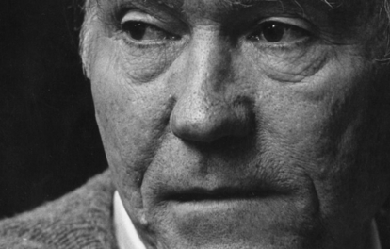
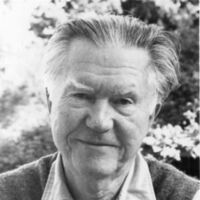
William Edgar Stafford (January 17, 1914 – August 28, 1993) was an American poet and pacifist, and the father of poet and essayist Kim Stafford. He was appointed the twentieth Consultant in Poetry to the Library of Congress in 1970. Early years Stafford was born in Hutchinson, Kansas, the oldest of three children in a highly literate family. During the Depression, his family moved from town to town in an effort to find work for his father. Stafford helped contribute to family income by delivering newspapers, working in sugar beet fields, raising vegetables, and working as an electrician's apprentice. During this time he had a near death experience in a local swimming hole. He graduated from high school in the town of Liberal, Kansas in 1933. After attending junior college, he received a B.A. from the University of Kansas in 1937. He was drafted into the United States armed forces in 1941, while pursuing his master's degree at the University of Kansas, but declared himself a conscientious objector. As a registered pacifist, he performed alternative service from 1942 to 1946 in the Civilian Public Service camps. The work consisted of forestry and soil conservation work in Arkansas, California, and Illinois for $2.50 per month. While working in California in 1944, he met and married Dorothy Hope Frantz with whom he later had four children (Bret, who died in 1988; Kim, writer; Kit, artist; Barbara, artist). He received his M.A. from the University of Kansas in 1947. His master's thesis, the prose memoir Down In My Heart, was published in 1948 and described his experience in the forest service camps. That same year he moved to Oregon to teach at Lewis & Clark College. In 1954, he received a Ph.D. from the University of Iowa. Stafford taught for one academic year (1955–1956) in the English department at Manchester College in Indiana, a college affiliated with the Church of the Brethren where he had received training during his time in Civilian Public Service. The following year (1956–57), he taught at San Jose State in California, and the next year returned to the faculty of Lewis & Clark. Career One striking feature of his career is its late start. Stafford was 46 years old when his first major collection of poetry was published, Traveling Through the Dark, which won the 1963 National Book Award for Poetry. The title poem is one of his best known works. It describes encountering a recently killed doe on a mountain road. Before pushing the doe into a canyon, the narrator discovers that she was pregnant and the fawn inside is still alive. Stafford had a quiet daily ritual of writing and his writing focuses on the ordinary. His gentle quotidian style has been compared to Robert Frost. Paul Merchant writes, "His poems are accessible, sometimes deceptively so, with a conversational manner that is close to everyday speech. Among predecessors whom he most admired are William Wordsworth, Thomas Hardy, Walt Whitman, and Emily Dickinson." His poems are typically short, focusing on the earthy, accessible details appropriate to a specific locality. Stafford said this in a 1971 interview: I keep following this sort of hidden river of my life, you know, whatever the topic or impulse which comes, I follow it along trustingly. And I don't have any sense of its coming to a kind of crescendo, or of its petering out either. It is just going steadily along. Stafford was a close friend and collaborator with poet Robert Bly. Despite his late start, he was a frequent contributor to magazines and anthologies and eventually published fifty-seven volumes of poetry. James Dickey called Stafford one of those poets "who pour out rivers of ink, all on good poems."[6] He kept a daily journal for 50 years, and composed nearly 22,000 poems, of which roughly 3,000 were published. In 1970, he was named Consultant in Poetry to the Library of Congress, a position that is now known as Poet Laureate. In 1975, he was named Poet Laureate of Oregon; his tenure in the position lasted until 1990. In 1980, he retired from Lewis & Clark College but continued to travel extensively and give public readings of his poetry. In 1992, he won the Western States Book Award for lifetime achievement in poetry. Death Stafford died of a heart attack in Lake Oswego, Oregon on August 28, 1993, having written a poem that morning containing the lines, "'You don't have to / prove anything,' my mother said. 'Just be ready / for what God sends.'" In 2008, the Stafford family gave William Stafford's papers, including the 20,000 pages of his daily writing, to the Special Collections Department at Lewis & Clark College. Kim Stafford, who serves as literary executor for the Estate of William Stafford, has written a memoir Early Morning: Remembering My Father, William Stafford (Graywolf Press). References Wikipedia—http://en.wikipedia.org/wiki/William_Stafford_(poet)
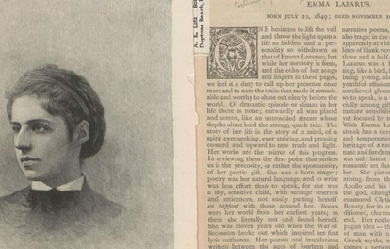
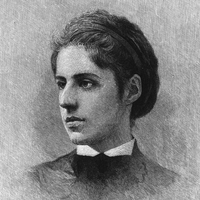
Emma Lazarus (July 22, 1849– November 19, 1887) was an American poet born in New York City. She is best known for “The New Colossus”, a sonnet written in 1883; its lines appear inscribed on a bronze plaque in the pedestal of the Statue of Liberty installed in 1903, a decade and a half after Lazarus’s death. Lazarus was born into a large Sephardic-Ashkenazi Jewish family, the fourth of seven children of Moses Lazarus and Esther Nathan, The Lazarus family was from Germany, and the Nathan family was originally from Portugal and resident in New York long before the American Revolution.
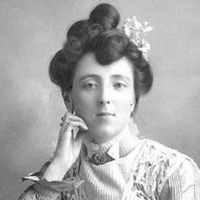
Lucy Maud Montgomery OBE (November 30, 1874– April 24, 1942), publicly known as L. M. Montgomery, was a Canadian author best known for a series of novels beginning in 1908 with Anne of Green Gables. The book was an immediate success. The central character, Anne Shirley, an orphaned girl, made Montgomery famous in her lifetime and gave her an international following. The first novel was followed by a series of sequels with Anne as the central character. Montgomery went on to publish 20 novels as well as 530 short stories, 500 poems, and 30 essays. Most of the novels were set in Prince Edward Island, and locations within Canada’s smallest province became a literary landmark and popular tourist site—namely Green Gables farm, the genesis of Prince Edward Island National Park. She was made an officer of the Order of the British Empire in 1935. Montgomery’s work, diaries and letters have been read and studied by scholars and readers worldwide. Early life Lucy Maud Montgomery was born in Clifton (now New London) in Prince Edward Island on November 30, 1874. Her mother Clara Woolner Macneill Montgomery died of tuberculosis when Maud was 21 months old. Stricken with grief over his wife’s death, Hugh John Montgomery gave custody to Montgomery’s maternal grandparents. Later he moved to Prince Albert, North-West Territories (now Prince Albert, Saskatchewan) when Montgomery was seven. She went to live with her maternal grandparents, Alexander Marquis Macneill and Lucy Woolner Macneill, in the nearby community of Cavendish and was raised by them in a strict and unforgiving manner. Montgomery’s early life in Cavendish was very lonely. Despite having relatives nearby, much of her childhood was spent alone. Montgomery credits this time of her life, in which she created many imaginary friends and worlds to cope with her loneliness, with developing her creativity. Montgomery completed her early education in Cavendish with the exception of one year (1890–1891) during which time she was in Prince Albert with her father and her stepmother, Mary Ann McRae. In November 1890, while in Prince Albert, Montgomery’s first work, a poem entitled “On Cape LeForce,” was published in the Charlottetown paper, The Daily Patriot. She was as excited about this as she was about her return to her beloved Prince Edward Island in 1891. The return to Cavendish was a great relief to her. Her time in Prince Albert was unhappy, for she did not get along with her stepmother and because by, “... Maud’s account, her father’s marriage was not a happy one.” In 1893, following the completion of her grade school education in Cavendish, she attended Prince of Wales College in Charlottetown, and obtained a teacher’s license. She completed the two-year program in one year. In 1895 and 1896, she studied literature at Dalhousie University in Halifax, Nova Scotia. Writing career, romantic interests, and family life Published books and suitors Upon leaving Dalhousie, Montgomery worked as a teacher in various Prince Edward Island schools. Though she did not enjoy teaching, it afforded her time to write. Beginning in 1897, she began to have her short stories published in magazines and newspapers. Montgomery was prolific and had over 100 stories published from 1897 to 1907. During her teaching years, Montgomery had numerous love interests. As a highly fashionable young woman, she enjoyed “slim, good looks” and won the attention of several young men. In 1889, at 14, Montgomery began a relationship with a Cavendish boy named Nate Lockhart. To Montgomery, the relationship was merely a humorous and witty friendship. It ended abruptly when Montgomery refused his marriage proposal. The early 1890s brought unwelcome advances from John A. Mustard and Will Pritchard. Mustard, her teacher, quickly became her suitor; he tried to impress her with his knowledge of religious matters. His best topics of conversation were his thoughts on Predestination and “other dry points of theology”, which held little appeal for Montgomery. During the period when Mustard’s interest became more pronounced, Montgomery found a new interest in Will Pritchard, the brother of her friend Laura Pritchard. This friendship was more amiable but, again, he felt more for Montgomery than she did for him. When Pritchard sought to take their friendship further, Montgomery resisted. Montgomery refused both marriage proposals; the former was too narrow-minded, and the latter was merely a good chum. She ended the period of flirtation when she moved to Prince Edward Island. However, she and Pritchard did continue to correspond for over six years, until Pritchard caught influenza and died in 1897. In 1897, Montgomery accepted the proposal of Edwin Simpson, who was a student in French River near Cavendish. Montgomery wrote that she accepted his proposal out of a desire for “love and protection” and because she felt her prospects were rather low. While teaching in Lower Bedeque, she had a brief but passionate romantic attachment to Herman Leard, a member of the family with which she boarded. In 1898, after much unhappiness and disillusionment, Montgomery broke off her engagement to Simpson. Montgomery no longer sought romantic love. In 1898, Montgomery moved back to Cavendish to live with her widowed grandmother. For a nine-month period between 1901 and 1902, she worked in Halifax as a substitute proofreader for the newspapers Morning Chronicle and The Daily Echo. Montgomery was inspired to write her first books during this time on Prince Edward Island. Until her grandmother’s death in March 1911, Montgomery stayed in Cavendish to take care of her. This coincided with a period of considerable income from her publications. Although she enjoyed this income, she was aware that “marriage was a necessary choice for women in Canada.” Marriage and family In 1908, Montgomery published her first book, Anne of Green Gables. An immediate success, it established Montgomery’s career, and she would write and publish material (Including numerous sequels to Anne) continuously for the rest of her life. Shortly after her grandmother’s death in 1911, she married Ewen (spelled in her notes and letters as “Ewan”) Macdonald (1870–1943), a Presbyterian minister, and they moved to Ontario where he had taken the position of minister of St. Paul’s Presbyterian Church, Leaskdale in present-day Uxbridge Township, also affiliated with the congregation in nearby Zephyr. Montgomery wrote her next eleven books from the Leaskdale manse. The structure was subsequently sold by the congregation and is now the Lucy Maud Montgomery Leaskdale Manse Museum. The Macdonalds had three sons; the second was stillborn. The great increase of Montgomery’s writings in Leaskdale is the result of her need to escape the hardships of real life. Montgomery underwent several periods of depression while trying to cope with the duties of motherhood and church life and with her husband’s attacks of religious melancholia (endogenous major depressive disorder) and deteriorating health: "For a woman who had given the world so much joy, [life] was mostly an unhappy one." For much of her life, writing was her one great solace. Also, during this time, Montgomery was engaged in a series of "acrimonious, expensive, and trying lawsuits with the publisher L.C. Page, that dragged on until she finally won in 1929.” Montgomery stopped writing about Anne in about 1920, writing in her journal that she had tired of the character. She preferred instead to create books about other young, female characters, feeling that her strength was writing about characters who were either very young or very old. Other series written by Montgomery include the “Emily” and “Pat” books, which, while successful, did not reach the same level of public acceptance as the “Anne” volumes. She also wrote a number of stand-alone novels, which were also generally successful, if not as successful as her Anne books. Later life In 1926, the family moved into the Norval Presbyterian Charge, in present-day Halton Hills, Ontario, where today the Lucy Maud Montgomery Memorial Garden can be seen from Highway 7. In 1935, upon her husband’s retirement, Montgomery moved to Swansea, Ontario, a suburb of Toronto, buying a house which she named Journey’s End, situated on Riverside Drive along the east bank of the Humber River. Montgomery continued to write, and (in addition to writing other material) returned to writing about Anne after a 15-year hiatus, filling in previously unexplored gaps in the chronology she had developed for the character. She published Anne of Windy Poplars in 1936 and Anne of Ingleside in 1939. Jane of Lantern Hill, a non-Anne novel, was also composed around this time and published in 1937. In the last year of her life, Montgomery completed what she intended to be a ninth book featuring Anne, titled The Blythes Are Quoted. It included fifteen short stories (many of which were previously published) that she revised to include Anne and her family as mainly peripheral characters; forty-one poems (most of which were previously published) that she attributed to Anne and to her son Walter, who died as a soldier in the Great War; and vignettes featuring the Blythe family members discussing the poems. The book was delivered to Montgomery’s publisher on the day of her death, but for reasons unexplained, the publisher declined to issue the book at the time. Montgomery scholar Benjamin Lefebvre speculates that the book’s dark tone and anti-war message (Anne speaks very bitterly of WWI in one passage) may have made the volume unsuitable to publish in the midst of the second world war. An abridged version of this book, which shortened and reorganized the stories and omitted all the vignettes and all but one of the poems, was published as a collection of short stories called The Road to Yesterday in 1974, more than 30 years after the original work had been submitted. A complete edition of The Blythes Are Quoted, edited by Benjamin Lefebvre, was finally published in its entirety by Viking Canada in October 2009, more than 67 years after it was composed. Death Montgomery died on April 24, 1942. A note was found beside her bed, reading, in part, “I have lost my mind by spells and I do not dare think what I may do in those spells. May God forgive me and I hope everyone else will forgive me even if they cannot understand. My position is too awful to endure and nobody realizes it. What an end to a life in which I tried always to do my best.” Montgomery died from coronary thrombosis in Toronto. However, it was revealed by her granddaughter, Kate Macdonald Butler, in September 2008 that Montgomery suffered from depression– possibly as a result of caring for her mentally ill husband for decades– and may have taken her own life via a drug overdose. But, there is another point of view. According to Mary Rubio, who wrote a biography of Montgomery, Lucy Maud Montgomery: The Gift of Wings (2008), the message may have been intended to be a journal entry as part of a journal that can no longer be found, rather than a simple suicide note. During her lifetime, Montgomery published 20 novels, over 500 short stories, an autobiography, and a book of poetry. Aware of her fame, by 1920 Montgomery began editing and recopying her journals, presenting her life as she wanted it remembered. In doing so certain episodes were changed or omitted. She was buried at the Cavendish Community Cemetery in Cavendish following her wake in the Green Gables farmhouse and funeral in the local Presbyterian church. Legacy Collections The L. M. Montgomery Institute, founded in 1993, at the University of Prince Edward Island, promotes scholarly inquiry into the life, works, culture, and influence of L. M. Montgomery and coordinates most of the research and conferences surrounding her work. The Montgomery Institute collection consists of novels, manuscripts, texts, letters, photographs, sound recordings and artifacts and other Montgomery ephemera. Her major collections are archived at the University of Guelph. The first biography of Montgomery was The Wheel of Things: A Biography of L. M. Montgomery (1975), written by Mollie Gillen. Dr. Gillen also discovered over 40 of Montgomery’s letters to her pen-friend George Boyd MacMillan in Scotland and used them as the basis for her work. Beginning in the 1980s, her complete journals, edited by Mary Rubio and Elizabeth Waterston, were published by the Oxford University Press. From 1988–95, editor Rea Wilmshurst collected and published numerous short stories by Montgomery. Most of her essays, along with interviews with Montgomery, commentary on her work, and coverage of her death and funeral, appear in Benjamin Lefebvre’s The L. M. Montgomery Reader, Volume 1: A Life in Print (2013). Despite the fact that Montgomery published over twenty books, “she never felt she achieved her one 'great’ book”. Her readership, however, has always found her characters and stories to be among the best in fiction. Mark Twain said Montgomery’s Anne was “the dearest and most moving and delightful child since the immortal Alice". Montgomery was honoured by being the first female in Canada to be named a fellow of the Royal Society of Arts in England and by being invested in the Order of the British Empire in 1935. However, her fame was not limited to Canadian audiences. Anne of Green Gables became a success worldwide. For example, every year, thousands of Japanese tourists “make a pilgrimage to a green-gabled Victorian farmhouse in the town of Cavendish on Prince Edward Island”. In 2012, the original novel Anne of Green Gables was ranked number nine among all-time best children’s novels in a survey published by School Library Journal, a monthly with primarily U.S. audience. The British public ranked it number 41 among all novels in The Big Read, a 2003 BBC survey to determine the “nation’s best-loved novel”. Landmarked places Montgomery’s home of Leaskdale Manse in Ontario, and the area surrounding Green Gables and her Cavendish home in Prince Edward Island, have both been designated National Historic Sites. Montgomery herself was designated a Person of National Historic Significance by the Government of Canada in 1943. Bala’s Museum in Bala, Ontario, is a house museum established in 1992. Officially it is “Bala’s Museum with Memories of Lucy Maud Montgomery”, for Montgomery and her family stayed in the boarding house during a July 1922 holiday that inspired her novel The Blue Castle (1926). The museum hosts some events pertaining to Montgomery or her fiction, including re-enactment of the holiday visit. Honours and awards Montgomery was honoured by Britain’s King George V as an Officer of the Order of the British Empire (OBE), as there were no Canadian orders, decorations or medals for civilians until the 1970s. Montgomery was named a National Historic Person in 1943 by the Canadian federal government. Her Ontario residence was designated a National Historic Site (NHS) in 1997 (Leaskdale Manse NHS), while the place that inspired her famous novels, Green Gables, was designated “L. M. Montgomery’s Cavendish NHS” in 2004. On May 15, 1975, the Post Office Department issued a stamp to “Lucy Maud Montgomery, Anne of Green Gables” designed by Peter Swan and typographed by Bernard N. J. Reilander. The 8¢ stamps are perforated 13 and were printed by Ashton-Potter Limited. A pair of stamps was issued in 2008 by Canada Post, marking the centennial of the publication of Montgomery’s classic first novel. The City of Toronto named a park for her (Lucy Maud Montgomery Park) and in 1983 placed a historical marker there near the house where she lived from 1935 until her death in 1942. On November 30, 2015 (her 141st birthday), Google honoured Lucy Maud Montgomery with a Google Doodle published in twelve countries.


